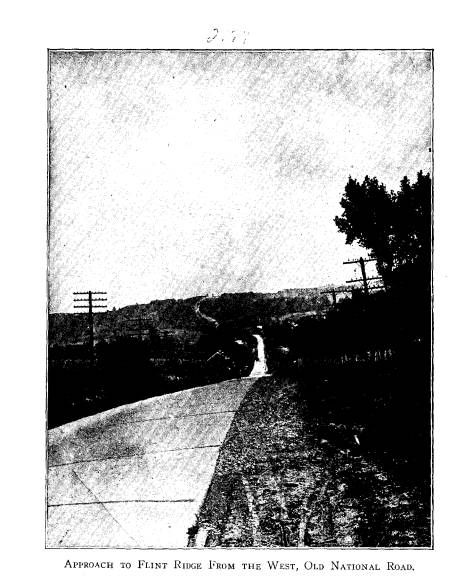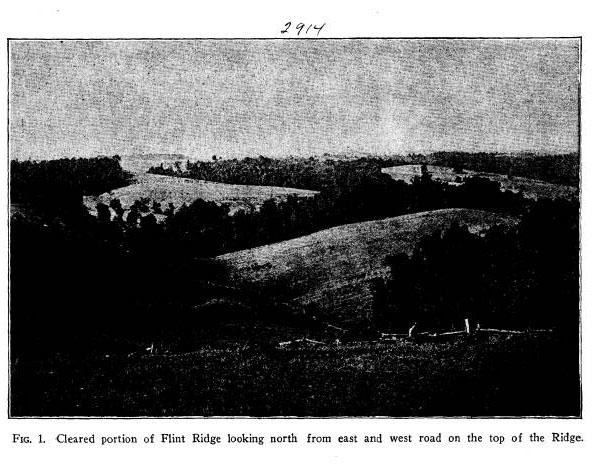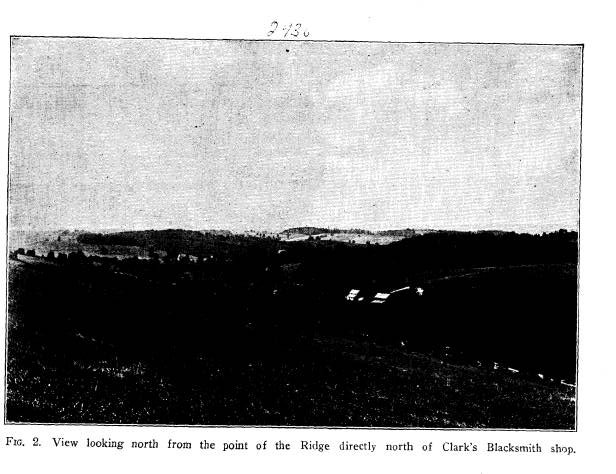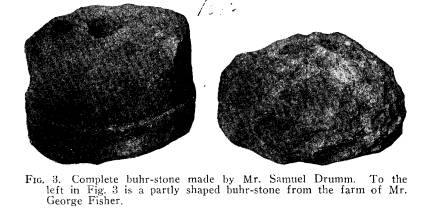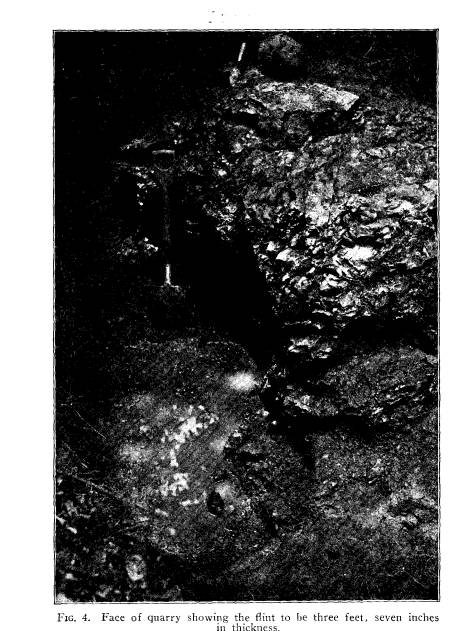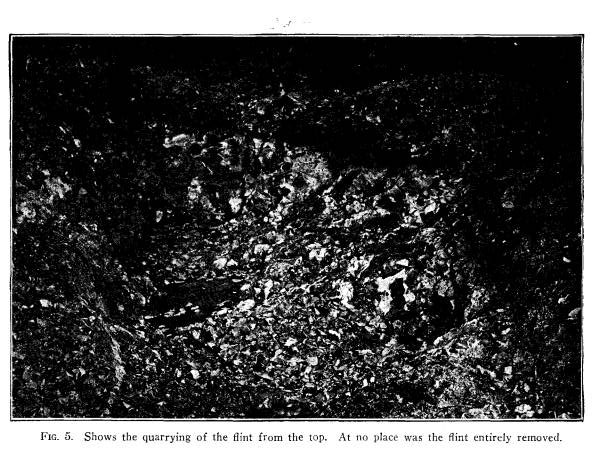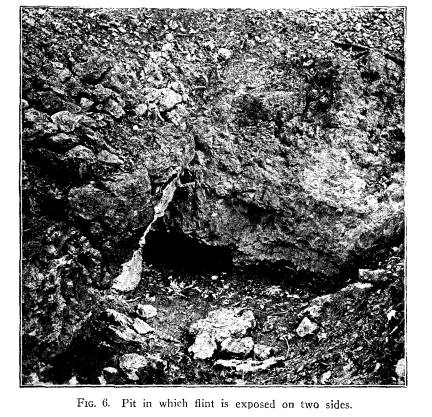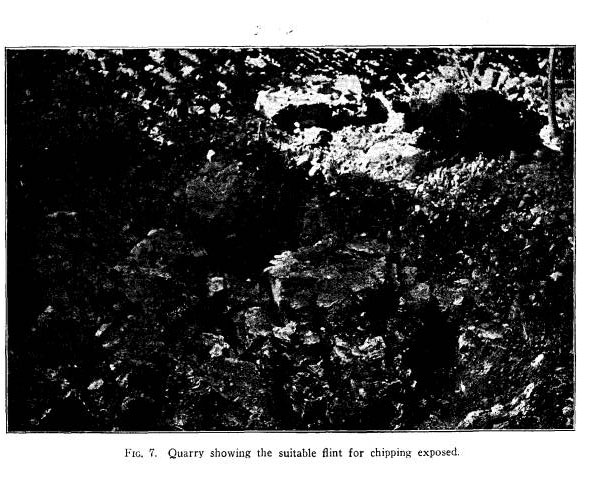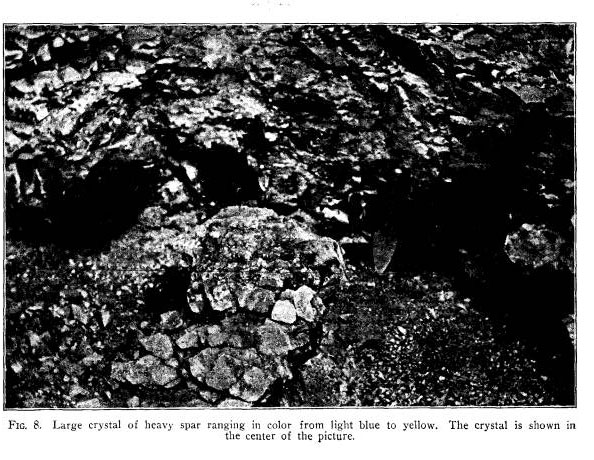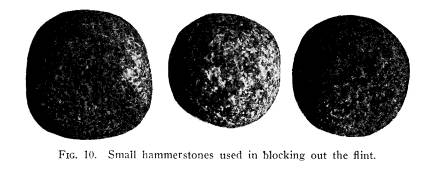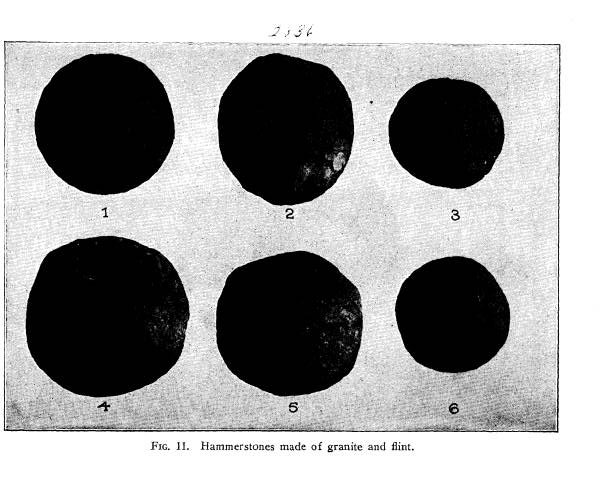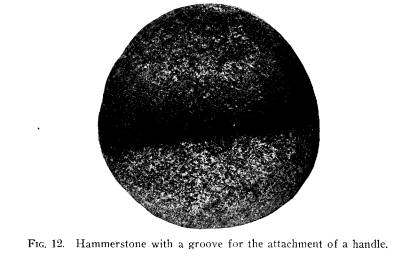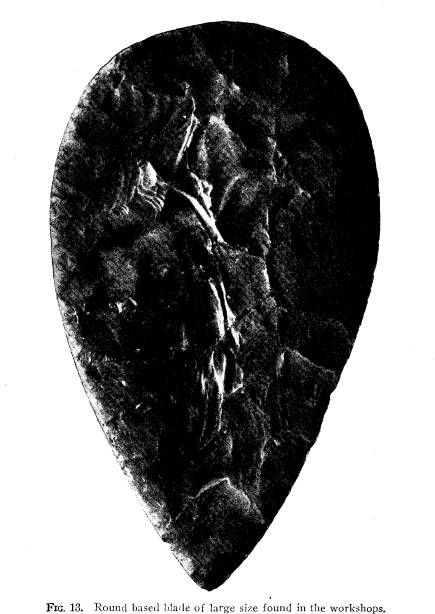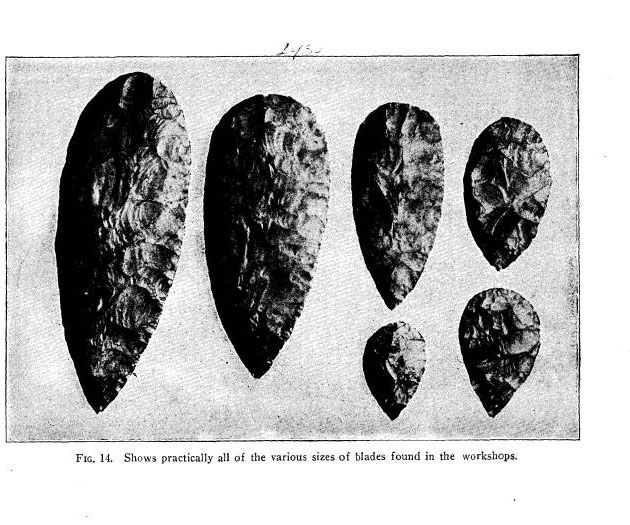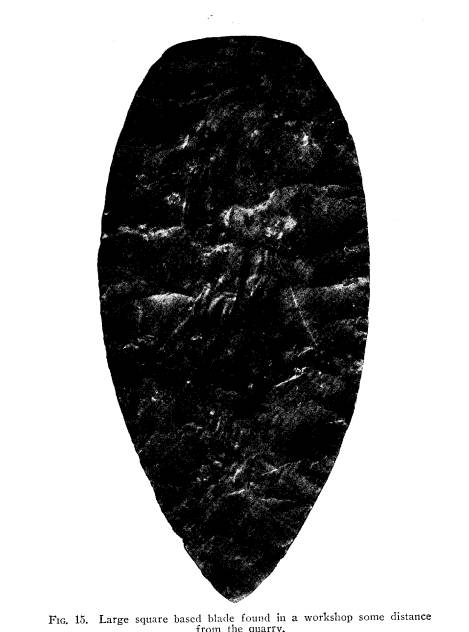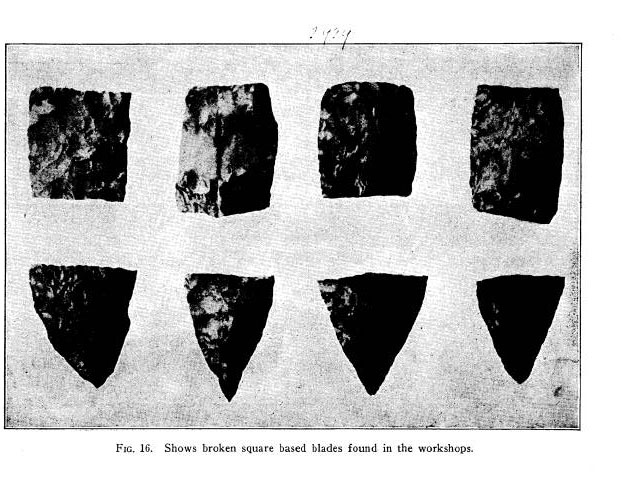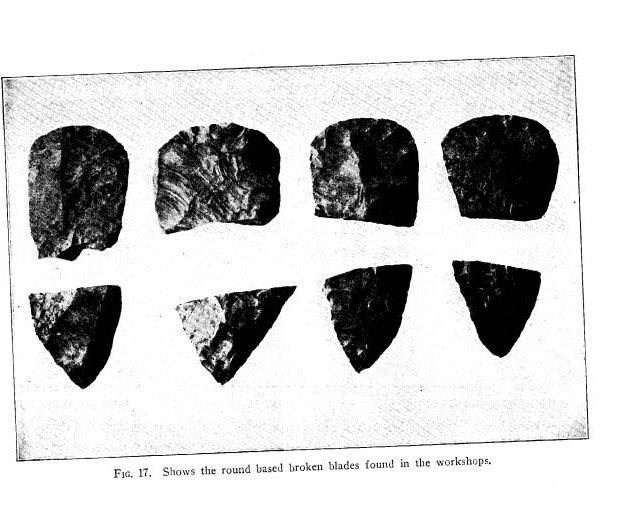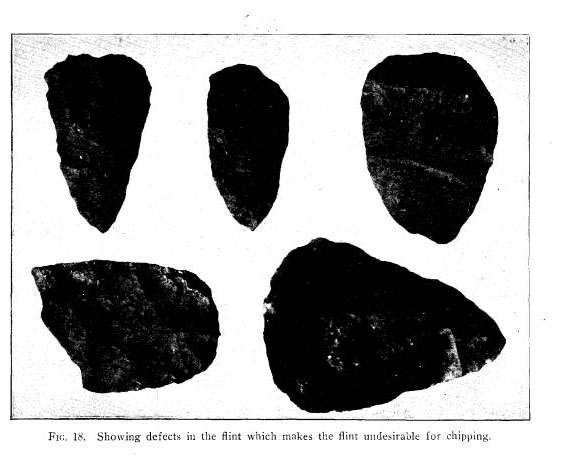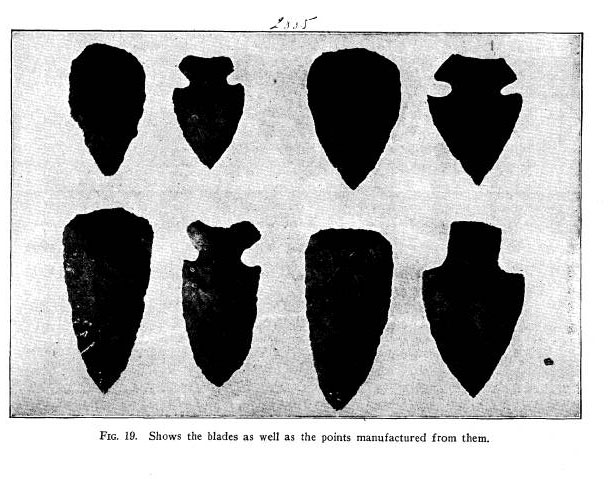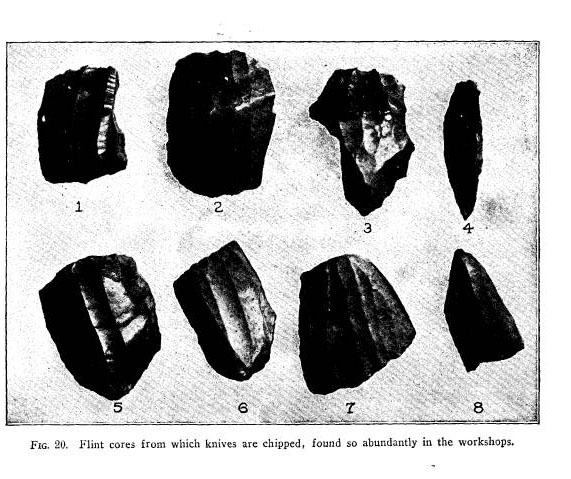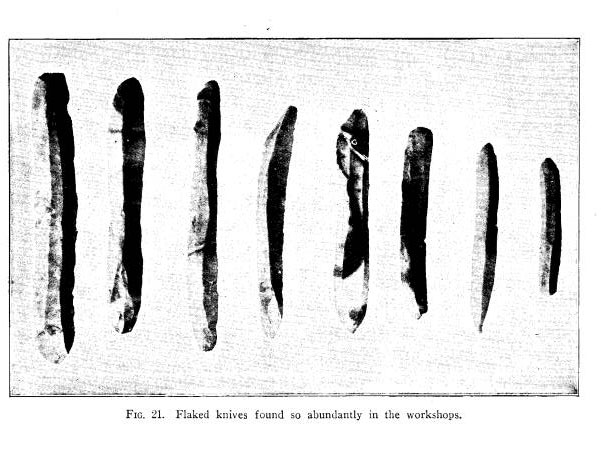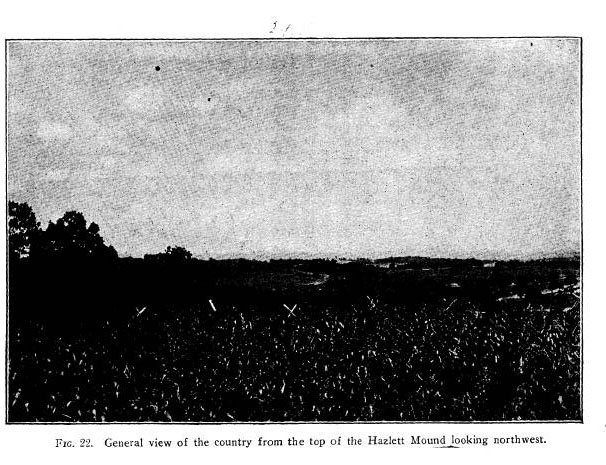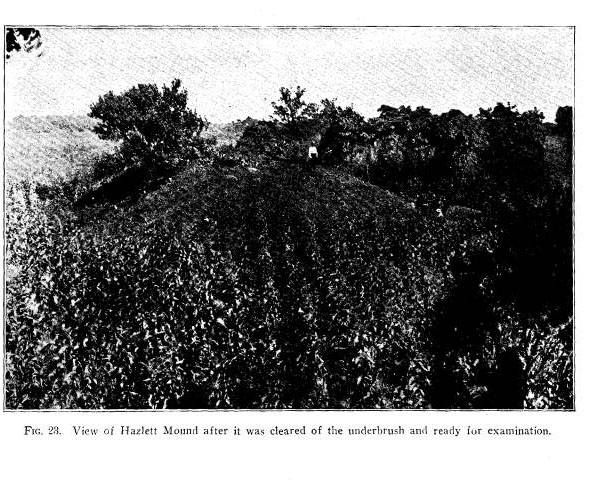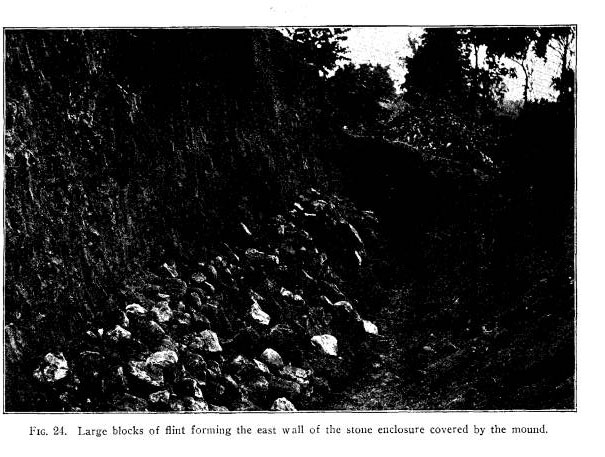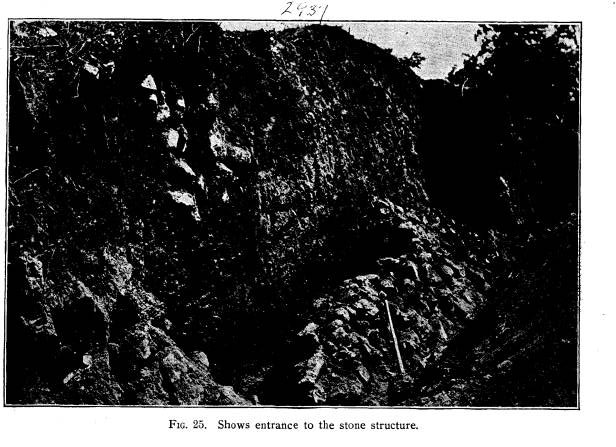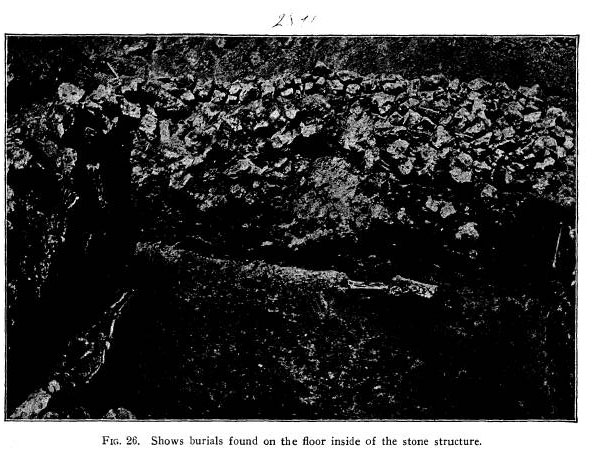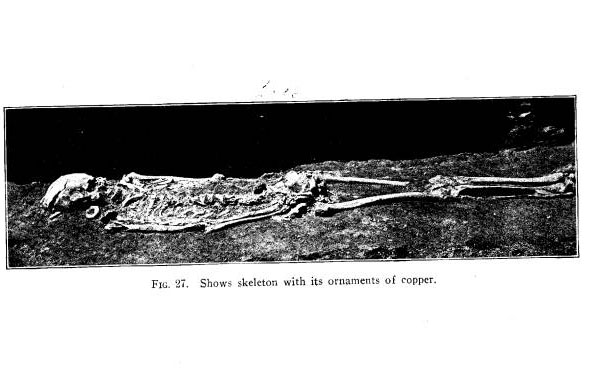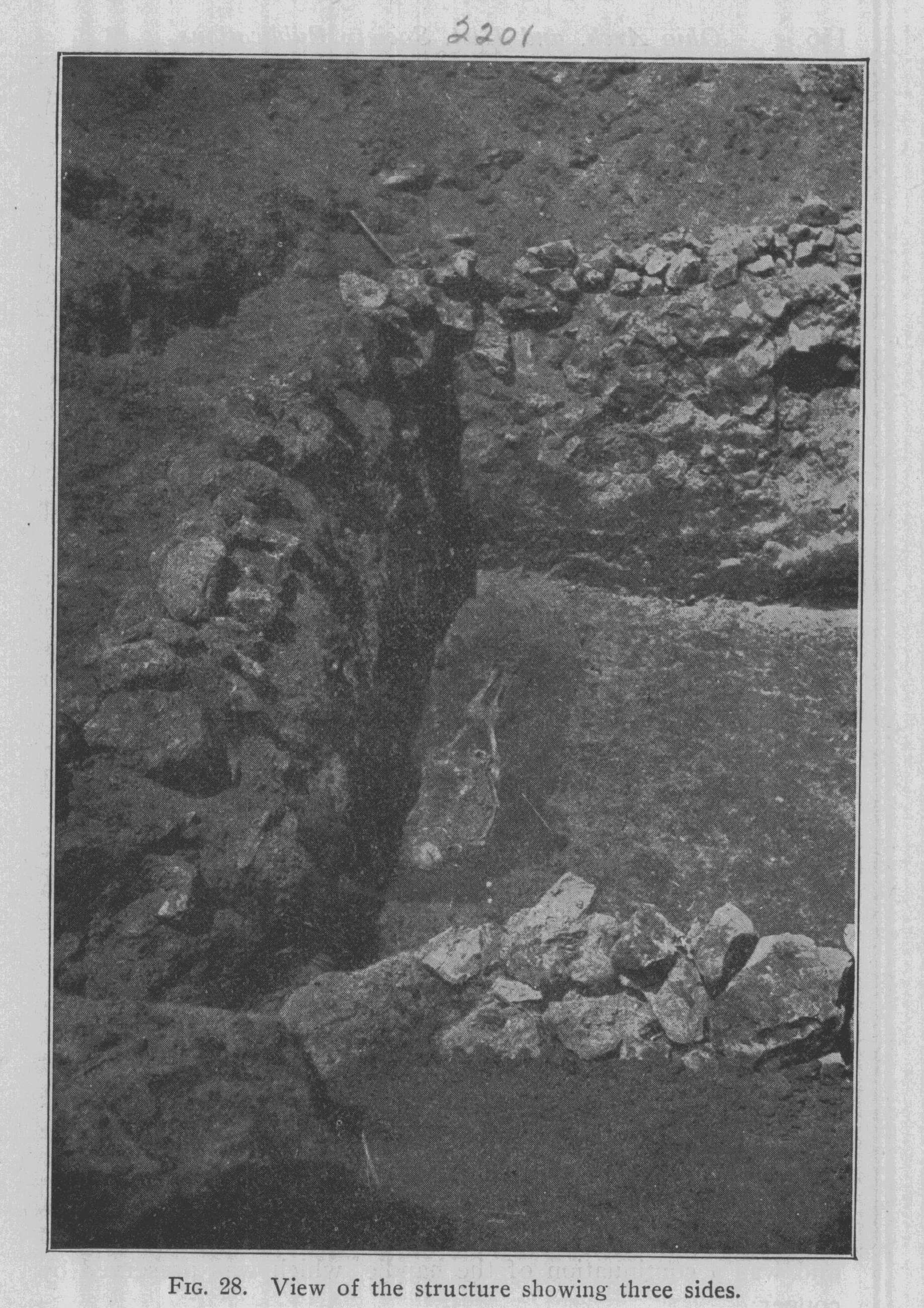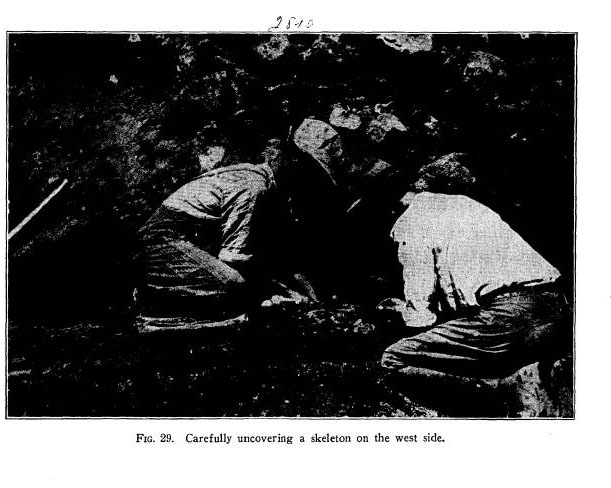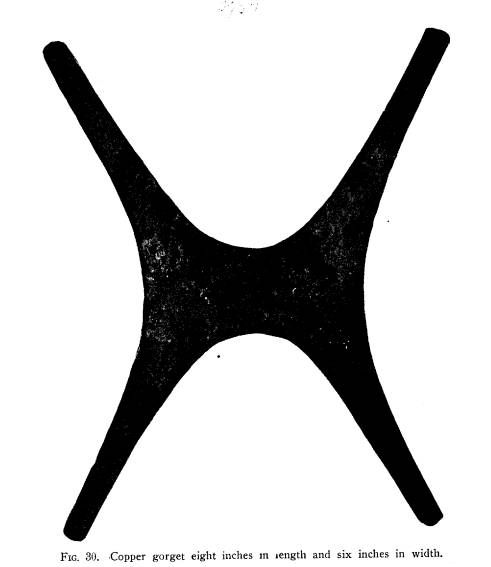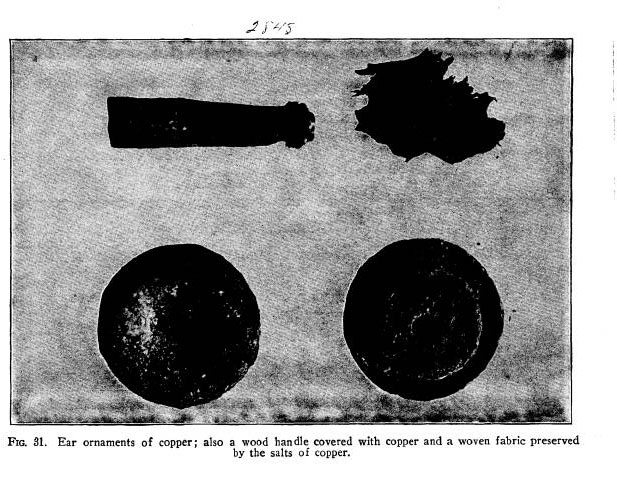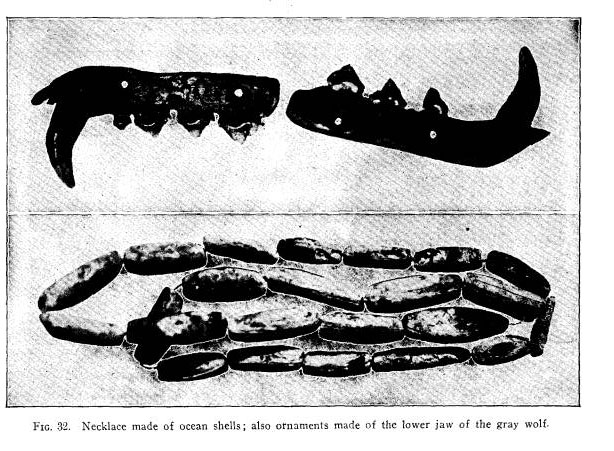Ohio History Journal
|
|
|
(90) |
FLINT RIDGE.
BY WILLIAM C. MILLS.
INTRODUCTORY NOTE:
The explorations and studies recorded
in this paper
on Flint Ridge were undertaken for the
purpose of se-
curing for exhibition in the State
Museum a complete
collection of the various kinds of
flint found at Flint
Ridge as well as the implements used in
quarrying the
flint from its natural bed. A
preliminary examination
of Flint Ridge beginning at its western
edge in Hopewell
Township, Licking County, Ohio, extending
eastward
and ending in western Muskingum County,
a distance of
practically eight miles, made it
apparent that a more
extended and systematic study of the
quarrying, manu-
facture, and distribution of flint
objects was necessary
to enable one to cope with the many
complex problems
arising from a study of the art of
shaping the raw
material into artificial forms to meet
the varied needs of
a primitive people.
As the search for specimens of flint
and the imple-
ments used in quarrying progressed, it
was found neces-
sary to examine a number of so-called
pits, in search
of the evidence of quarrying flint and
to find the flint in
its original bed, partly quarried, and
this proved a very
difficult task in the region of the
suitable flint for making
knives, arrow, and spear points, for
this flint had prac-
tically all been removed from its
original bed, carried to
workshops and made into suitable forms
convenient for
transportation.
(91)
92
Ohio Arch. and Hist. Society Publications.
The examination soon developed the fact
that prim-
itive man may have developed quarrymen
who devoted
their time exclusively to producing the
raw material and
turning over such material to a second
industry, that of
roughing-out the blank forms. This,
however, may
have been accomplished by the same
individual but at
different times and places.
The third process comprised the art of
trimming,
making into special forms and finishing
blades or cores
ready for transportation.
Therefore, it seems that the three well
defined steps
would give rise to three separate
industries carried on
by the same individuals at different
times or places or
by different groups of experts trained
in their respec-
tive industry. The Flint Ridge quarries
for the most
part show that the first and second
steps were accom-
plished mainly at the quarries, because
primitive man
found it uneconomical to transport blocks
of material
of which nine-tenths would be thrown
away as useless;
and further, the promising blocked-out
piece might de-
velop seams or geodes of crystals that
would destroy its
usefulness in making the desired
implement. The work-
shop developed many such specimens,
showing the ad-
visability of working out the form of
the article to be
shaped in such a manner as to test the
material and its
capacity for specialization before
leaving the source of
supply. In other words, Flint Ridge
became a great
factory site, in which two principal
commodities were
manufactured and made ready to
transport by man-
power over the entire state of Ohio and
into other states
where the raw material was lacking. The
two commodi-
ties mentioned were the flint blades,
ranging in size from
Flint Ridge. 93
the small arrowhead to the blades for
making into
spears, and the flint core, from which
the flint knife was
made. The flint used for these purposes
was found in
the region of the cross-roads directly
north of Browns-
ville. The workshops in close proximity
to the quarries
contained many rejects, showing that
even with expert
selection many of the pieces were not
adapted for
making the desired flint knife with a
long, keen cutting
edge, so highly prized by primitive man.
As the examination of the quarries and
the region
surrounding them progressed, many
problems arose con-
cerning the probable prehistory Indians
who did the
extensive quarrying. All the
surrounding workshop
sites were examined but no implements
other than those
used in shaping the blades were found.
However, at the
west end of the ridge was located a
large mound sur-
rounded by a circle made of blocks of
flint and earth.
This mound was examined and the culture
determined
to be the Hopewell, the highest in
point of advanced
prehistory civilization in Ohio,
showing that this culture
had established themselves at the site
of this wonderful
supply of the most desirable raw
material used in the
manufacture of artificial forms to meet
the varied needs
of the primitive inhabitants. A
detailed account of the
examination of this mound will be found
in the pages
following the account of the
examination of the quarry
sites.
I am greatly indebted to many
individuals for their
assistance in the examination of Flint
Ridge and espe-
cially to Mr. H. C. Shetrone, assistant
curator, who
carried forward the work on occasions
when other
duties connected with the Museum
compelled me to be
94 Ohio Arch. and Hist. Society Publications.
absent; to Dr. Clark Wissler of the
American Museum
of Natural History, New York, who spent
a short time
in July, 1918, and again in August,
1919, for his help
and counsel; to Professor J. Arthur
MacLean of the
Cleveland Museum of Art, for his
assistance in the ex-
ploration of the mound located at the
west end of the
"Ridge;" to Mr. Jay Clark, a
resident of the "Ridge"
for more than forty years, for help and
information
given and specimens presented to the
museum. To the
many residents of the "Ridge"
I wish to extend my
thanks for assistance in the laborious
excavations made
in various sections and for specimens
presented to the
museum.
THE FIELD OF INVESTIGATION.
Flint Ridge is a very irregular
plateau-capped line of rugged
hills, located in Licking and Muskingum
counties, about midway
between Newark, the county seat of
Licking, and Zanesville, the
county seat of Muskingum. The region is a part of the great
Allegheny Plateau which has an elevation
of approximately
1,200 feet at the western end of the ridge in Licking,
gradually
decreasing eastward, probably due to the
greater eroding agen-
cies.
The Licking River, located about five miles north of
Flint Ridge, runs approximately east and
parallel with Flint
Ridge and empties into the Muskingum
River. The small rib-
bon-like valley plains, with small
streams fed by springs from
the "Ridge", would furnish no
means of water transportation to
and from the source of supply;
consequently the only way to
reach the "Ridge" was by
trails through the deep tangled forest,
leading to the great manufacturing
industrial center of the pre-
historic Indian, in the region of
Clark's blacksmith-shop, located
at the road-crossing three miles
directly north of Brownsville.
It is striking to observe that the
varied phenomena studied are
assembled within a radius of one mile of
this place, and at the
extreme eastern end of the
"Ridge". The flint occurring outside
of these two places was of no practical
use to primitive man, be-
|
(95) |
96 Ohio Arch. and Hist. Society Publications.
cause of its unfitness for chipping into
form on account of im-
purities.
In the region of the cross-roads the
best examples of flint
may be found, as well as the largest
quarries located on the
"Ridge".
An examination of the quarries developed
the fact that
only a very small portion of the flint
deposit was of use to pre-
historic man in the manufacture of
artifacts, as much of the
flint was full of seams and cracks which
did not permit of the
manufacture of a desired artifact with
any degree of certainty,
as demonstrated by the many broken
blades found on the site
of the work shop.
Another feature of the flint in this
section was the presence
of countless geodes filled with quartz
crystals. The geodes
varied in size from that of a pea or
less to large geodes of from
twelve to fourteen inches in
diameter. The quartz crystals
found in the geodes were usually small,
but the large geodes
generally contained large crystals.
Apparently the crystals, un-
less very large, were not used in any
way and were thrown away
with the useless flint.
The flint found outside of the regions
where it was quarried
is very porous and fossiliferous, and
very frequently mixed with
calcareous or argillaceous material,
which rendered it useless
to primitive man as far as chipped
implements were concerned.
The flint at the west end of the
"Ridge", in Licking County,
was especially useless to primitive man,
but the early white
settler found it well adapted to the
making of buhr-stones, used
in grinding grain into flour. Near the western edge of the
outcrop of the flint, several partly
formed buhr-stones, each
weighing a ton or more, may be seen
where they were quarried,
upon the farm of Mr. William Hazlett,
near the only large
mound located upon the
"Ridge".
The flint at the eastern end of the
"Ridge" is likewise unfit
for implement making but well adapted
for buhr-stones. In the
early pioneer days of Ohio, Mr. Samuel
Drumm quarried the
flint in suitable blocks and fashioned
them into small hand buhr-
stones.
One of the buhr-stones complete and one partly shaped
|
Vol. XXX-7 (97) |
|
98 Ohio Arch. and Hist. Society Publications. and found at the quarry where many more were in evidence are shown in Fig. 3. The farm upon which the quarry is located is owned by Mr. George Fisher, who kindly presented to the museum a fine sample of the partly shaped buhr-stone shown to the right in Fig. 3 as well as a buhr-stone sent from France and used as a sample stone. The manufacture of these small buhr-stones during the early settlement of the country was a very great convenience to the people, as water mills for grinding grain could only be con- structed where proper conditions prevailed, and often long dis- |
|
|
|
tances would be traveled to find such a mill; consequently the small hand mill made from Flint Ridge flint was very desirable, and the manufacture of the buhr-stones proved to be a very lucrative industry. The buhr-stones manufactured at the Drumm site were sent to a point on the Old National Road, three miles to the south, where they were transported by ox teams as far west as the Mississippi River and as far east as Pittsburgh. The preliminary examination of numerous quarries upon Flint Ridge made it apparent that the solution of the problem of quarrying the flint was unsolved and, to arrive at any definite conclusions, a systematic study of the entire area was necessary. |
Flint Ridge. 99
Consequently the field of investigation
was extended to every
part of the ridge where primitive man
attempted to quarry and
make use of the flint.
GEOLOGY OF FLINT RIDGE.
As a preliminary step to a study of the
evidence of human
industry on Flint Ridge, it is very
important that the geology
of the place be reviewed. Aboriginal flint quarries have long
been known at Flint Ridge, but prior to
1830 little was known
to the scientist concerning the geology
of this region. The first
writer referring to the aboriginal
quarries was Caleb Atwater in
his "Western Antiquities",
page 28, as follows:
"A few miles below Newark, on the
south side of the Lick-
ing, are some of the most extraordinary
holes, dug in the earth,
for number and depth, of any within my
knowledge, which be-
longed to the people we are treating
of. In popular language,
they are called 'wells' but were not dug
for the purpose of
procuring water, either fresh or salt.
"There are at least a thousand of
these 'wells'; many of
them are now more than twenty feet in
depth. A great deal
of curiosity has been excited, as to the
objects sought for by
the people who dug these holes. One
gentlemen nearly ruined
himself by digging in and about these
works, in quest of the
precious metals; but he found nothing
very precious. I have
been at the pains to obtain specimens of
all the minerals, in and
near these wells. They have not all of
them been put to proper
tests; but I can say, that rock
crystals, some of them very beauti-
ful, and horn stone, suitable for arrow
and spear heads, and a
little lead, sulphur, and iron, was all
that I could ascertain cor-
rectly to belong to the specimens in my
possession. Rock crys-
tals, and stone arrow and spear heads,
were in great repute
among them, if we are to judge from the
numbers of them
found in such of the mounds as were
common cemeteries. To
a rude people, nothing would stand a
better chance of being
esteemed, as an ornament, than such
articles.
"On the whole, I am of the opinion,
that these holes were
dug for the purpose of procuring the
articles above named;
and that it is highly probable a vast
population, once here, pro-
cured these, in their estimation, highly
ornamental and useful
articles. And it is possible that they
might have procured some
lead here, though by no means probable,
because we no where
find any lead which ever belonged to
them, and it will not very
soon, like iron, become an oxide, by
rusting."
100
Ohio Arch. and Hist. Society Publications.
In 1836 the first geological survey of
Ohio was published,
in which Dr. Hildreth calls attention to
the flint quarries in Ohio
and comments on their great extent,
beginning in Jackson County
and extending north to Muskingum County,
and calls the flint a
calcareo-silicious formation.
Mr. J. S. Newberry, Chief Geologist of
the Ohio Geological
Survey, in discussing the carboniferous
system in Ohio com-
ments at some length concerning the
famous Flint Ridge:*
"The origin of the silex in these
flinty limestones has never
been satisfactorily explained. It has
sometimes been attributed
to hot springs, of which the water contained much
silica, but
the general distribution of the flint
and the immense number of
fossils sometimes contained in it,
seemed to me insurmountable
objections to this view. It appears to me more probable that
the silica was derived from microscopic
organisms, such as the
diatoms. It is well known that at the present time very exten-
sive deposits of silicious earth
('infusorial earth') are being made
in our lakes and lagoons. These are frequently associated with
shell marl and sometimes bog iron
ore. In the Tertiary age,
even more extensive beds of diatomaceous
silica were formed
than any belonging to the present age
yet discovered, the polish-
ing slate of Bilin, ('tripoli'),
Monterey, and Nevada 'infusorial
earths,' etc. In the older formations no
such strata are found,
and yet it is hardly probable that the
low forms of life from
which these beds of silica are derived
are of modern date. From
some experiments recently made by Mr.
Henry Newton at my
request, we learn that the silicious
shields of diatoms are more
soluble than almost any other form of
silica known, and it seems
to me quite possible that in the older
diatomaceous earths the
individual forms have disappeared by
solution, and the mass
has been converted into compact
amorphous silica, such as we
find in our beds of chert. I would, therefore, suggest that in
many parts of the lagoons which, from
time to time, occupied
the coal area, the shields of diatoms
accumulated in beds
of considerable thickness, and these,
now blended and consoli-
dated by solution, form our Coal Measure
buhr-stones.
"In this view, the wide diffusion
of the silica and its blend-
ing with and shading into purer
limestone as though deposited
in the quieter nooks of the broad
lagoon, its association with
fossils and iron, are all harmonious and
confirmatory facts. If
hot springs had furnished the silica, we
should be pretty certain
*Geological Survey of Ohio, Vol. 2, page
142-143.
Flint Ridge. 101
to find it impregnating other strata
than the limestone, and
should probably find some masses or
accumulations heaped up
about the source of supply, but we have
discovered nothing of
the kind; and the careful observation of the facts in
the case
has convinced me that the silica, like
the lime, is indigenous and
not exotic, that is, that it accumulated
particle by particle as a
sediment at the bottom of water where it
was slowly drawn
from solution and fixed by some vital
agency."
In 1878, Mr. M. C. Read, Special
Assistant of the Geo-
logical Survey of Ohio, wrote the
Geology of Licking County,
(Geological Survey of Ohio, Vol. 3,) and
I quote from his re-
port as follows:
"The number of this series found on
the summit of most
of the hills in the south-east part of
the county is the flint, which
is ordinarily regarded as on the horizon
of Coal No. 6, the Great
Vein of Perry and Hocking counties, this
coal being represented
by the thin and worthless seam
underlying the flint. I am dis-
posed, however, to regard the flint as
the equivalent of the
'Black Marble,' so-called, of Coshocton
county-which has be-
neath it a thin seam of coal, and is
found in places only ten or
twelve feet below Coal No. 6-and the
representative of the
drab limestone of Columbiana county,
often found directly be-
neath No. 6. In Coshocton county this 'Black Marble' often
passes into a chert, as do all the
limestones of that county, but
none of them form so extensive and
continuous deposits as the
flint of Flint Ridge. Any one traversing this ridge for the
first time would be surprised to find
such a deposit on such a
geological horizon. It simulates very
accurately the broken-up
debris of a vertical dike, the fragments
often covered with per-
fect crystals of quartz, the rock itself
being highly crystalline
and often translucent. It is something of a puzzle to under-
stand how such a deposit is found in a
series of undisturbed
and unmodified sedimentary rocks. The adjacent surfaces of
two blocks of the chert are often found
covered with quartz
crystals of considerable size, as
thoroughly interlocking with
each other as if one were a cast, and
the other the matrix. I
cannot imagine conditions which would
spread such a deposit
over the floor of a sea or any other
body of water. A substitu-
tion of silicious matter deposited from
solution, in the place of
a soluble limestone previously
deposited, is the only plausible
explanation. This substitution has taken place over large areas
in this part of the State, and has left
these silicious deposits
only upon the horizons of the different
limestones."
102
Ohio Arch. and Hist. Society Publications.
Mr. Read inserts as a foot-note the
following:
"The question of the origin of the
silica, which so often
replaces the carbonate of lime in the
Coal Measure limestones,
is discussed at some length in Vol. 2 of
this report, and it is
there attributed to DIATOMS. These microscopic plants, as is
well known, bear silicious frustules,
which accumulate at the
bottom of some lakes and ponds till they
form beds many miles
in extent and several feet in thickness.
They probably inhabited
portions of the shallow land-locked
basins where the limestones
were formed in such numbers as to supply
silica for concretions
or cherty layers, and sometimes to
replace the calcareous bed
entirely, just as we find the
diatomaceous earths locally replacing
shell-marl in the bottoms of our lakes
and marshes. The silica
which forms the frustules of the diatoms
has been proved by
experiment to be unusually soluble, and
in the flint beds, the in-
dividual forms have doubtless been
either so completely dissolved
or so enveloped in soluble silica as to
be lost. The quartz crys-
tals referred to by Mr. Read as coating
the blocks and filling
the crevices and cavities of the flint,
are evidently of modern
origin, and have been formed by a
deposit of silica, from solu-
tion, in whatever receptacles were open
to it."
Mr. Wilbur Stout in his Geology of
Muskingum County,
(Bulletin No. 21, Geological Survey of Ohio), assigns the Flint
Ridge flint to the horizon of the
ferriferous limestone. I quote
from Mr. Stout's report at length, as he
covers the geological
phenomena of Flint Ridge:
"In ascending order the important
rock stratum above the
Clarion coal is the Ferriferous or
Vanport limestone, which is
also often called Gray limestone owing to its color.
This mem-
ber is not persistent and is variable in character in
the western
part of Muskingum County where the bed
is above cover. How-
ever, the scattered deposits of this
member may be followed
with some certainty from Perry County on
the south into Coshoc-
ton County on the north. From Perry
County it may be traced
southward to the large and important
field in Vinton, Jackson,
Gallia, Scioto, and Lawrence counties,
where it has characteristic
development and excellent continuity.
Owing to many wants in
deposition and to rapid changes in
character the bed is followed
with more difficulty from Coshocton
County northeastward to
Mahoning and Columbiana counties where
it again has good
volume, and from where it has been directly traced into
Law-
rence and Beaver counties, Pennsylvania.
Flint Ridge. 103
"Two well-defined phases of the
Ferriferous member are
present in Muskingum County. In most of
the county the up-
per phase is a bed of rather pure flint
or limestone, in many
places several feet in thickness. The
flint is best represented by
the massive stratum that extends along
Flint Ridge from Poverty
Run in Hopewell Township, Muskingum
County, to the Porter
School in Franklin Township, Licking
County. Dr. Orton as-
signed this rock to the horizon of the
Ferriferous limestone.*
"Miss Clara Gould Mark also assigns
the flint to this horizon.
In 1916-17 the members of this Survey traced the stratum by
stringers of flint and impure limestone
to Bairds Furnace, Hock-
ing County, where the member is a true
limestone, definitely
known to be correlative with the more
massive and persistent
Ferriferous beds of southern Ohio. Further, in its extension
northward from Flint Ridge, Muskingum
County, the stratum
undergoes many changes, as it may be
represented by thin local
beds of flint, or by flint and
limestone, or by limestone alone.
Along the ridge known as the Highlands,
in Cass Township,
the horizon is marked locally by a thick
bed of gray limestone
very similar to that present in southern
Ohio. North of this,
along Graham Ridge, in Coshocton County,
thin beds of flint
again appear, and near Warsaw local
deposits of impure lime-
stone were observed. Similar conditions were noted in parts
of Tuscarawas County. Although local, variable, and scat-
tered, the deposits of this flinty phase
in Muskingum County
are sufficiently pronounced to be
followed with certainty, and
in the opinion of the writer they are
correlative with the Fer-
riferous limestone of eastern and
southern Ohio."
"The flint beds of the Ferriferous
member in Hopewell
and Franklin townships of Licking County
are the largest in
Ohio, and were extensively worked by the
aborigines, who dug
hundreds of pits along Flint Ridge in
the mining of this ma-
terial. The stratum was evidently worked
for a long period,
and the material, identified by its
characteristic fossils, is widely
distributed. Much of the flint chipped into arrows, knives,
scrapers, etc., and found in the burial
mounds and earthworks
of the mound builders, as well as that
similarly worked and
found on the surface in this and
adjoining states, is from Flint
Ridge. The field is of exceptional
interest both to the geologist
and archaeologist. The outcrop
measurements indicate that the
light-colored bed of flint is from 1 to
10 feet in thickness, and
that it averages about 5 or 6 feet. This stratum is directly
bedded on the shaly limestone, the
thickness of which, from sur-
face indications, is from 5 to 20 feet,
or even more. Owing to
*Geol. Survey Ohio, Vol. V. p. 870.
104 Ohio Arch. and Hist. Society
Publications.
the
slumping of the flint and to the nature of the covering no
good sections
of the entire interval were obtained.
"Along
the ridge at the head of Berry Run, in Hopewell
Township, the
light flint is massive, and varies from 3 to 10 feet
in
thickness. The bed was mined by the
aborigines more ex-
tensively
in this locality than on either the western or eastern
part
of the ridge. A section taken in a
ravine east of the cross-
roads
follows:
Ft. In.
Flint, light
....................... ..... 5
Limestone,
thin to medium bedded. shaly. Ferriferous 7
Covered ................................... 32
Sandstone, parts
covered
................................. 32
S h
ale
.................................................... 1
Sandstone
........................ 23
Shale,
calcareous, with shaly limestone.
1
Limestone,
dark siliceous .............. .. 8
Shales,
calcareous, with shaly limestone. 5
Limestone,
hard ......................... Lower Mercer 3 6
S
hale
................................... 2
Limestone,
hard ........................ 1 8
"In
this locality the light-colored flint or upper phase of the
Ferriferous
member is bedded on the shaly limestone or lower
phase. No separation, except an irregular bedding
plane, is
evident,
thus suggesting that both rocks were laid down during
the
same general deposition period. In
the above section the
interval
between the Ferriferous member and the Lower Mercer
limestone
is about normal for the region."
ECONOMIC
VALUE OF THE FERRIFEROUS LIMESTONE AND FLINT.
"The
great value to the aborigines of the flint beds of the
Ferriferous
member in Muskingum County, and also in Licking
County,
is attested by the large quantities of earth and rocks
mined
in the excavation of the hundreds of pits scattered along
Flint
Ridge and along its spurs. This Flint was certainly held
in
high esteem by these ancient people, who used it in the manu-
facture
of implements for domestic purposes, for hunting, and
for
war. Arrows, knives, skinners,
scrapers, hoes, and drills
made
of flint from this locality, and recognized by the remains,
are
scattered over a wide area in the Ohio Valley and in the
Lake
Erie region. Their method of quarrying
the flint and of
shaping
the implements is a subject of interest, but it belongs
more
to the province of archaeology than to that of present-day
geology
and hence needs no further discussion here."
Flint
Ridge. 105
CHEMICAL
ANALYSIS OF THE FLINT.
"The
chemical as well as the physical properties of the
light-colored
flint on Flint Ridge are such that the material may
be
utilized for the manufacture of silica brick or for potter's
flint
of white ware bodies. The deposit along
the main ridge
for a
distance of more than 5 miles was sampled by taking pieces
thrown out of
the pits excavated by the aborigines. This sample
weighing
more than 100 pounds was properly crushed and pre-
pared
for analysis. The chemical work was done by Prof. D.
J. Demorest,
who reports the following results:
Silicia,
SiO2 ............................... 96.40
Alumina,A ....................................... 1.52
Ferric oxide, FeO
................................... .48
Lim e, CaO
........................................... .30
Magnesia,
MgO .......................................04
W
ater, comb., H20................................... 1.20
99.94
CHARACTER
AND ORIGIN OF THE FLINT.
I have
given the view of Newberry as to the origin of the
flint
at Flint Ridge, which he attributes to diatomaceous plants,
a view
acquiesced in by Mr. Read, who wrote the Geology of
Licking
County, 1878. Mr. Stout gives three
views as to the
possible
origin of the flint at Flint Ridge, and I quote from his
report:
"The
flint in the black layers is very solid and dense except
for
small cavities, which are irregularly spaced and frequently
lined
with transparent quartz crystals. The
gray flint is also
solid,
and has a banded and somewhat mottled appearance, prob-
ably
due to original deposition, and the analysis shows it to be
anhydrous
or nearly so. The coal formation flints
seldom con-
tain
more than 2 per cent of water. Flint has a
hardness com-
parable
with that of quartz, and it breaks with a deep conchoidal
fracture,
the perfection of which depends on the texture of the
material. This characteristic fracture is much more
evident in
the
compact, vitreous varieties than in the more porous, grainy
types
which are mixtures of amorphous silica and quartz sand
or
calcareous or argillaceous material. It
varies from nearly
transparent
to coal-black, and from the strikingly mottled or
banded
types to those traversed by small veins of different
colored
material of later formation.
"Three
views are tenable as to the origin of the flints as-
sociated
with the limestones or stratified on the horizons of
these
rocks:
106 Ohio Arch. and Hist. Society
Publications.
"(a) That the flint was formed by direct
precipitation of
the siliceous matter by
silica-secreting organisms.
"(b) That the flint was the resultant of chemical
action
of soluble silica and
other components in the sea water upon
the calcium carbonate
of newly formed limestone. In this case
the change took place
while the limestone was forming or while
it was yet under the
direct influence of the salt brines.
"(c) That circulating
ground waters, charged with sili-
ceous and organic
components which acted upon limestone de-
posited under normal
conditions and buried by later sediments,
slowly removed the
calcium carbonate and deposited silica in its
place. This action began as soon as the beds were
covered by
other material and is
still effective. Under this condition
the
flint is entirely of
secondary origin.
"In regard to the
first view, it is necessary to account for
large quantities of
soluble silica and a means of precipitating it.
The flint beds found
in the coal formations of Muskingum
County are directly
associated with limestones, or more often
occur on the horizons
of these rocks. Judging from fossil and
other evidence, these
limestones are of organic origin and were
laid down in shallow
basins of the sea. The natural
inference
is, therefore, that
the flint has a similar derivation.
Some of
the low forms of life,
such as radiolaria, sponges, and diatoms,
which inhabit both
fresh and salt water, secrete silica.
Such
material secreted by
an organism is hydrous and glassy and is
readily dissolved by
waters containing carbonates of the alkalis
or alkaline
earths. Carbon dioxide from a living or
a decaying
organism, however,
readily precipitates this silica. It is
also
thrown down by
hydrolysis in the presence of weak acids such
as may occur from
decaying organic matter. The rocks on
these flint horizons
show that a profusion of life existed in
these early seas, a
part of which was evidently silica-secreting,
and the presence, or
rather decay, of which would produce con-
ditions often
favorable for the direct deposition of silica.
"Some of the
flint deposits in the coal formations of Mus-
kingum, Perry, and
Coshocton counties suggest such an origin.
The material is very
free from calcium and magnesium carbon-
ates, has the mottling
characteristic of gelatinous precipitates,
and shows no distinct
nuclei attending concretionary growths.
Further, the relation
of flint beds to limestone strata in some
localities is also of
interest. As noted in some of the preceding
sections, a flint
layer may lie either directly above or directly
below a limestone
which is very free from flinty material. Later-
ally the rocks often
pass in a regular way from limestone or from
sandstone to flint in
about the same way as shale to sandstone
Flint Ridge. 107
or carbonaceous shale
to coal. Flint deposits are also nearly
as abundant in the Pottsville
and Allegheny formations of this
area as limestone
deposits. With varying conditions in
these
shallow seas where
both siliceous and calcareous matter are be-
ing secreted, flint
should result as one extreme and limestone as
the other.
"The second view
is closely related to the first, but it differs
in that soluble
silica replaces the calcium carbonate of newly
formed
sediments. As shown by several writers,
the replace-
ment of the calcium
carbonate of shells, corals, etc., by silica is
easily effected. The
most favorable conditions would be where
both silica and
calcium carbonate are being secreted contempo-
raneously by organic
life. Such silica is very soluble and
the
calcium carbonate is
in a state which can be readily attacked,
thus making
replacement easy. The
alkalinity and pressure of
the water also aid in
this work. The waters of
these ancient
seas contained a
profusion of both plant and animal life, secret-
ing either silica or
calcium carbonate; they were warm, owing to
the shallow depth and
to the prevailing climate, and were par-
tially saturated with
mineral and organic components which aid
in chemical action,
all of which conditions favored replacement
changes attending
deposition.
"Such an origin
appears plausible for some of the flint
strata in the coal
formations of this area. In a certain
bed,
as the Upper Mercer,
for instance, flint may be overlain by
limestone or
limestone by flint, or the two may occur in almost
any proportion. Substitutions are apparent, but it is
difficult
to determine whether
they took place during the early period of
formation or during a
later period by the action of circulating
waters. The deposits are intermediate stages between
a lime-
stone and a
flint. The limestones on these horizons
are every-
where fossiliferous
and, as would be expected, the flints con-
tain the same
fossils, although they are less abundant and less
delicatedly
preserved, with the possible exception of the FUSU-
LINA and other small
types. The state of the fossils indicates
alteration
changes. The flint in local areas has a
banded and
orbicular structure
which shows secondary arrangement of the
matter. Replacements in many of these beds are
evident, but
it is uncertain how
much is to be accredited to the early stages
of formation and how
much to the later.
"Taking the
third view next into consideration, the original
rock is a regularly
deposited limestone covered by later sedi-
ments. Circulating ground waters holding soluble
silica and
organic components in
solution attack the limestone, taking cal-
cium carbonate into
solution and depositing silica in its place.
108
Ohio Arch. and Hist. Society Publications.
The flints are thus of secondary
origin. The chemical action
involved is the same as it is in the
second case, except that it
is performed through the medium of
circulating ground waters
in place of salt brines. The change is
effected under less favor-
able conditions, but the force is
operative over a longer time in-
terval. The action began with the covering of the bed
by later
sediments and is still effective. The
question is whether the ac-
tion of ground waters is sufficient to
change thick beds of lime-
stone extending over wide areas to
strata of flint. On the
Boggs horizon the flint is from a few
inches to 1 foot 6 inches
thick, and is rather local; on the Upper
Mercer horizon the
volume varies from 1 foot to more than
10 feet, and it is very
persistent over a wide area, and on the
Ferriferous horizon it
varies from a few inches to 10 feet, and
is often continuous
for several miles. The variation in the
character of these mem-
bers is shown under the discussion of
their stratigraphy.
"The work of ground waters in
effecting the solution of
one component and the substitution of
another is well known,
and this action accounts for the nodules
of flint in many of the
massive limestone and chalk beds. It is a question, however, as
to whether this accounts for the origin
of the thick beds of
flint in the coal formations of this
area. Where the section was
measured on the Lee Moore farm in
Jefferson Township,
Coshocton County, the lower layer is
composed of irregular
masses of relatively pure flint and
limestone which are distinctly
separated, but with the flint
constituting the greater part. Re-
placement of calcium carbonate by silica
is strongly suggested.
Above this layer, there is 11 feet of
thin to medium-bedded shaly
limestone containing practically no
flint, and directly overlying
this shaly limestone there are two
layers of flint which are only
slightly calcareous at most, and which
contain no large irregular
masses of limestone. If these two beds were originally lime-
stone the transformation from limestone
to flint has been quite
complete. The series thus shows
limestone beds lying between
flint strata. If these flint beds were formed through the action
of circulating waters on limestone,
subsequent to the formation
of the entire deposit, then the
limestones occupying the middle of
the deposit should also show evidence of
the same influence,
which is not the case. The structure of
the deposit, therefore,
seems to show that these rocks were laid
down in about the same
condition as that in which they are now
found."
MEANS OF IDENTIFICATION OF FLINT.
Flint objects found upon the surface of
practically every
portion of Ohio are very often difficult
to identify as to source.
Flint Ridge. 109
The flint from Flint Ridge varies
greatly in different parts of
the deposit, but in the region of the
pits the flint is very com-
pact, almost free from impurities, and
possesses all the colors
and shades found in flint. Much of the
flint is blue or a grayish-
blue translucent chalcedony. In some places a glassy variety
is found in connection with the
grayish-blue variety and ranges
from almost perfect transparency to
complete opacity. In an-
other section jasper predominates, with
a wide range of color
from dark red through the various shades
of yellow; also a
banded, or ribbon variety, with
alternating stripes of light and
dark gray, brown and black.
In the central part of the great pit
region southeast of
Clark's blacksmith-shop the flint has
practically all been removed
from its bed, and here is found the most
beautiful of the various
colored chalcedony showing the tints of
blue, red, green, purple,
brown, yellow and white.
A careful examination of specimens of
flint collected from
the various quarrying sites and the
workshops is a necessary aid
in identifying the flint after it has
been made into objects by
primitive man and carried to remote
places.
In 1898 the writer undertook a
microscopical study of the
flint from Flint Ridge with a view of
determining the original
home of flint specimens found upon the
surface in practically
every part of the state, as well as
specimens taken from mounds
and village sites. More than 100 thin sections were made and
studied. The specimens from which the thin sections were cut
were secured from pits where the flint
was quarried and from
the workshops nearby. Thin sections of
flint from other known
quarries in the United States and Europe
were made for com-
parison. The microscopic thin sections from the Flint Ridge
flint proved of special interest and
value as a means of identifica-
tion, as many forms of siliceous
foraminifera as well as siliceous
sponges were in evidence, which would
readily identify the Flint
Ridge flint.
Only a few of the microscopic thin
sections from Flint
Ridge show diatom fragments and a few
show nothing definite
in the way of fossils, but the general
appearance of the compact
110
Ohio Arch. and Hist. Society Publications.
crypto-crystalline mass of chalcedonic
silica as shown by the
microscope was a great aid in
determining the Flint Ridge flint
when compared with flint from other
sections.
QUARRYING
The primitive inhabitants of Ohio made
use of various kinds
of rocks found in the drift, where the
agents of nature-the
glacier and floods,- had with almost
human discrimination de-
posited the tough granites and
quartzites in convenient places
for man to select and reduce to
available size and form But
the flint, so highly prized for the
manufacture of arrow and
spear-heads, occurs only in well defined
areas, where the outcrop
was available and served as a guide to
the location of the great
deposit a few feet under the soil.
Quarrying the flint really begins with
the removal of a
fragment from the exposed mass or from
the ground where it
was partly buried. It is only a step further when the mass of
the flint is uncovered, and the flint
removed on a large scale.
EXTENT OF OPERATIONS.
The extent of quarry operations in the
region where the
valuable flint is found centers around
the Cross Roads, three
miles directly north of Brownsville and
known as Clark's Black-
smith Shop. A circle with a diameter of one mile with the
center at the cross-roads would enclose
about all the sections
quarried, and the extent of the quarried
area within this circle
would not exceed 100 acres. When we take into account that
practically all of the flint used by the
various cultures represent-
ing the prehistoric Indian in Ohio came
from the Flint Ridge
region, we can readily understand and
appreciate the importance
of territory quarried. All trails
leading in the direction of Flint
Ridge would end there, or in other
words, Flint Ridge was the
trailsend of the prehistoric Indian in
Ohio. The accompanying
map, Fig. 3A, indicates the general
distribution of the flint de-
posit as well as the location of the
quarries as indicated by
excavations over the entire area.
Flint Ridge. 111
THE FLINT STRATUM.
The flint stratum is very irregular in
thickness and at no
place examined did the flint exceed six
feet in thickness, al-
though other reports from various
sections give a thickness
varying from five to ten feet. Directly
north of the cross-roads
the stratum measures fully six feet,
while following the pitted
section due north to near the edge or
outcrop, the depth of the
flint measures only eighteen inches, and
the top and bottom of
the deposit become very irregular and
more or less nodular in
form.
The weathering out of small fossils and calcite crystals,
which appear in great abundance near the
margins, makes the
flint appear cellular or porous in
structure. This condition
prevails in the greater bulk of the
flint found on the ridge. Con-
sequently prehistoric man discovered
that the greater part of the
flint was of no value for the
manufacture of artifacts and ac-
cordingly concentrated his efforts upon
the material that would
best meet his requirements. This was limited to two sections;
namely, the region of the cross-roads,
three miles north of
Brownsville, Licking County, and the
region of the Flint Ridge
School, Hopewell Township, Muskingum
County. The terri-
tory quarried over in these two sections
would perhaps not ex-
ceed 100 acres in extent.
METHOD OF QUARRYING.
After our examination of many of the
quarries upon the
"Ridge" the most striking and
marvelous phenomenon is that
the aborigines ever accomplished the
removal of such a thick
stratum of flint over a so comparatively
large area. Only those
who have ventured to remove the flint
from its natural bed with
modern tools can appreciate the skill
and perseverance necessary
in wresting from nature the flint needed
in fashioning the many
artifacts, with such primitive
tools. These tools are found in
abundance over the entire site and in
many instances where the
ancient quarryman had left them.
Mr. Gerard Fowke, while in the employ of
the Bureau of
Ethnology, made a systematic study of
"Flint Ridge" and his
report appears in the annual report of
the Smithsonian Institu-
112
Ohio Arch. and Hist. Society Publications.
tion for 1884, and in his work entitled
the "Archaeological His-
tory of Ohio" published in 1902. Mr.
Fowke spent much time
in a personal examination of the entire
"Ridge" and his recorded
observations on the method of quarrying
the flint are of especial
interest and value. I quote from his report to the Bureau of
Ethnology, published in Smithsonian
Report, 1884, page 864:
"How these ancients knew where to
find the best flint for
their purposes, unless indeed these
sites were chosen at random,
cannot be told. It also remains a
question as to how the flint
was quarried after its location was
determined. No doubt a thor-
ough examination of some of these pits
will throw much light
upon the methods in use among them for
obtaining the raw
material."
Quoting further from the same report,
page 867:
"The aborigines (meaning thereby
Indians, Mound Builders,
or whatever other name may be assigned
to the people who did
this work) knew that by digging into the
unweathered bed-rock
a quality of flint could be obtained
better suited to their pur-
poses than that which could be procured
along the outcrop. The
dirt was cleared away, by being carried
out in baskets or skins,
until the flint was exposed. Cleaning
out a space sufficient for
working purposes, a fire was built on
top of the rock, and when
it was heated water was thrown on it.
This would cause the
rock to crumble, and on clearing out the
fragments a fresh sur-
face of flint would be exposed around
the hole thus made in it,
from which pieces could be broken-off
with the large boulders
found in the vicinity. A question presents itself here, 'If this
method was used, why did they not follow
the flint stratum, once
they had found it, throwing the dirt
behind them, instead of open-
ing so many fresh holes?' The only
answer to be given is that
they did not, except in a few instances,
and that is all we know
about it."
Later, Mr. Fowke in his book
"Archaeological History of
Ohio", page 622, goes into detail
concerning the quarrying of
the flint by the use of fire:
"The pit taken as an illustration
was at least forty yards
from the one nearest to it; it was
thirty-two feet in diameter
inside of the wall of earth surrounding
it, which wall is now
two feet higher than the general surface
around it, and from
twenty to thirty feet across at the
base. This form indicates
Flint Ridge. 113
considerable age; as does an oak tree
nearly ten feet in circum-
ference, growing on the top of the wall.
In clearing out this
pit we could appreciate the patience and industry of
the abo-
riginal excavators. The clay subsoil was as hard and
tough as
frozen ground; frequently half a dozen
blows with a pick were
required to break off a clod as large as
a man's hand. To re-
move it with primitive tools seems almost an
impossibility. The
central part of the pit was filled with
material that had washed
in from the sides. Several days of steady digging were re-
quired, by three men accustomed to such
work, to reach the
surface of the flint stratum, which was
found at a depth of
nine feet. A hole five by eight and one-half feet had been
worked through; clearing this out, we
found the layer to be forty
inches thick. It rested directly upon a solid bluish limestone.
Both the flint and the limestone showed
that they had been
subjected to an intense heat. The flint was very solid where
not burnt, translucent, and a beautiful
light-blue in color. On
its top, on a corner formed by two
seams, was a saucer-shaped
depression between three and four inches
deep, in the bottom
of which was a handful of very fine
chips; just such as would
result from repeated blows with a large
hammer-stone, several
of which were found scattered through
the entire depth cleared
out.
One of them weighed nearly or quite a hundred pounds.
"Careful observation of this
pit-and others as well-
enables us to follow the prehistoric
quarryman in his labors.
He selected a spot where he thought the
superincumbent earth
not heavy enough to render the task of
removing it too tedious,
but at the same time was of ample
thickness to prevent injury
to the stone from weathering. He then sunk a pit, as
large as
he wished, to the surface of the flint.
On this he made a fire;
and when the stone was hot he threw
water on it, causing it to
shatter. Throwing aside the fragments,
he repeated the process
until he penetrated the underlying
limestone to a depth which
allowed him sufficient room to work
conveniently. The top and
freshly made face of the flint was
thickly plastered with potter's
clay, after which fire and water were
again utilized for clearing
away the limestone until a cavity was
formed beneath the flint
layer.
Thus a projecting ledge would be left, from which the
burnt parts were knocked off with heavy
stone hammers until
the unaltered flint was exposed; in the
same manner, blocks of
this were procured for converting into
implements. Where
the flint was well suited for the
purpose intended, or was easily
worked, the excavation was carried along
in the form of a trench,
the waste material being thrown to the
rear; under less favor-
able conditions the spot was
abandoned."
Vol. XXX -8.
114
Ohio Arch. and Hist. Society Publications.
Our examination of the quarries upon
Flint Ridge, made
with a view of ascertaining the method
of quarrying, does not
bear out and verify the findings of Mr.
Fowke concerning the
use of fire as an operating agent. On
the other hand, the evi-
dence found concerning the use of fire
as an agent in quarrying
the flint was purely negative, and I
doubt very much if fire was
used at all as an aid in removing the
flint from its natural bed.
I will go into detail concerning several
of the sites examined,
quoting from my field notes made at the
time of the excavations.
After a general examination of the
"Ridge" in company with
my assistant, Mr. Shetrone, we marked a
number of places for
examination, and this plan was
systematically carried out. The
first pit for examination was located in
the woods north and east
of the blacksmith-shop, about 300 feet
north from the road run-
ning east from the cross-roads. The property is owned by a
coal company with headquarters at
Newark, and is under the
direct supervision of Attorney R. E.
Jones, who aided us in
every way to make our work successful.
The pit was selected with a view of
finding the full vertical
ledge of flint exposed as the aboriginal
quarryman had left it.
In this we were partly successful, the
vertical ledge of flint
measuring three feet and seven inches,
while one foot and
eleven inches of flint had been removed
from the top surface
for a space of six feet by eight feet.
The flint on the top ap-
pears in nodular-like flat masses, from
two to three and one-
half feet in diameter, and the ancient
quarryman, taking ad-
vantage of the seams between the
nodules, was able to work
downward until the more desirable flint
was exposed. The top
of this quarry was covered with about
seven inches of soil,
accumulated during the more than a
century since the early
settler came to occupy the land. The top surface of the quarry
was more or less irregular, caused by
the early quarryman fol-
lowing the cracks or seams, or the lines
of least resistance in his
operations. Not the slightest indication was found in this
quarry to show that fire had been used
to supplement the ham-
merstones, several of which, varying in
size from about a pound
to one weighing upward of twenty-five
pounds, were found in
the pit. The hammerstones were made of
granite and quartzite.
Flint Ridge. 115
General indications shows that wedges,
perhaps made of wood
or horn, were used in dislodging the
desired pieces of flint.
Fig. 4 shows the face of the quarry
where the flint is three
feet and seven inches in thickness. On
the top of the flint lies
a large hammerstone of granite,
weighing about twenty-five
pounds, which was found at the bottom of
the pit. A close
inspection of this cut will show the
cracks and seams found in
the flint, which we later quarried out
to ascertain why this part
of the stratum had not been
utilized. We followed the seams,
using iron wedges instead of wood and
iron hammers instead
of stone, and thus were able to effect
our purpose. The flint
was found to be practically worthless
for making into artifacts,
and the entire mass of three feet and
seven inches in vertical
height, two feet in thickness, and three
to four feet in length
would have been quarried out and cast
aside in order to carry
forward the quarrying operations, with a
vertical wall or nearly
so to work from. The ancient quarryman apparently did not
perform such arduous labor to secure the
coveted flint unless
absolutely necessary, as was found to be
true in many of the
quarries examined in the various
sections of "Flint Ridge".
We also quarried samples of the good
flint exposed on the
top of this quarry and found the
prevailing color to be a light
blue-gray, translucent in thin sections,
but frequently varying in
color from a dep red and yellow with
shades of lilac. In many
instances, seams of translucent
chalcedony extended into the
mass of the flint, sometimes only about
one-eighth of an inch
apart, giving the flint the appearance
of banded agate. How-
ever, this banded flint when struck with
a heavy hammer would
separate into needle-like forms which
made the flint worthless
as far as primitive man was
concerned. The lilac-colored flint
from this quarry was often filled with
very small geodes of
quartz crystals, which did not greatly
interfere with its use as
implement-making material.
Adjoining the lilac-colored flint was a
slightly yellow-colored
flint containing much chalcedony and
larger clusters of quartz
crystals. The ancient quarryman had
uncovered a cluster more
than six inches in diameter, the
crystals ranging in size up to
one-half inch in diameter, colored a
light amethyst, and very
|
|
|
(116) |
Flint Ridge. 117
beautiful. Another very interesting
deposit of flint, known as
the brecciated form, was found in the
highly colored red flint in
this quarry. These deposits are not much
larger than a man's
fist, are usually oblong in general
form, and are made up of
small angular fragments of flint which
seem to have been held
in suspension in clear or slightly
colored chalcedony.
After the work of examination of Pit No.
1 was com-
pleted, a good opportunity to try the
experiment of quarrying
by the use of fire presented itself, for
here was the bed of flint
uncovered and an abundance of dry wood
at hand. The fire
was kindled, and was kept burning for
two hours, producing an
intense heat on the underlying face of
the flint. The fire was
then removed and two buckets of cold
water were thrown upon
the surface. I fully expected the flint
to break in large pieces,
but it merely checked and cracked into
small pieces to the depth
of perhaps half an inch. After the conclusion of this experi-
ment it was apparent that fire as a
direct agent in the quarrying
of flint was perhaps not effective. In this connection I may
state that at no time during the
examination of more than
twenty-five of the pits and quarries in
this section was there
evidence of the use of fire in the
quarrying of flint. In several
instances small amounts of charcoal were
found in the pits, but
so sparingly as to indicate that fire
was in use around the
quarry but not as a direct agent in
quarrying the flint.
The next quarry of special interest was
No. 3. This quarry
is located not far from the outcrop
along the cleared field on the
Coal Company's property, perhaps a
little more than half a
mile directly north-east from the
blacksmith-shop. The pit was
seventeen feet long and fifteen feet
wide, and at no point in the
quarry had the bottom of the flint been
reached. Near the
center of the quarry, to the west, a
projection of flint extended
almost across the quarry. Examination showed that the deposit
was a very compact variety of yellow
flint, practically devoid of
seams, which baffled our own efforts at
quarrying with our
modern chisels and hammers. We were very
desirous of secur-
ing large samples of this highly-colored
flint, and preparing the
stone for a charge of dynamite, were
able to secure good speci-
mens of both yellows and reds. Many instances exist on the
|
(118) |
Flint Ridge. 119
"Ridge" where the ancient
quarryman was compelled to aban-
don the removal of fine flint, owing to
the absence of cracks or
other defects which would enable him to
work through to the
base of the deposit, and thus gain a
vantage point for further
procedure. Our blast removed the flint for about two feet
in depth and it apparently had the same
consistency throughout.
This quarry is shown in Fig. 5. The projection of flint
which the aborigines could not detach,
and that portion of the
quarry directly to the north, are shown.
The flint was quarried
from the top and shows many places where
cracks were fol-
lowed and the flint removed. Fire was
not made use of, as no
charcoal or other indications of heat
were present. This quarry
was noted for its highly-colored flint,
both red and yellow, and
the number of hammers, large and small,
found on its floor.
Pit No. 4, shown in Fig. 6, is of
special interest, as the
flint is exposed on two sides of the
pit, for a distance of almost
six feet. Cracks in the flint are quite noticeable. The crack
appearing at the angle of the two walls
is quite large and evi-
dently the face of the exposed wall
follows this crack. The
quarryman at this point worked from
beneath. He found
the lower stratum of flint could be
detached something like
limestone, as evidenced by the finding
of slabs of flint a few
inches thick and eighteen inches across,
while in another quarry
nearby slabs of flint that had been
quarried from the bed but
not removed, measured three feet in
diameter and two and
one-half inches thick. The flint
offering the least resistance
to detachment seemed to be at the bottom
of this quarry. This
flint was of practically no use to
primitive man but by its
removal he was able to reach the good
flint which, in this in-
stance, is practically in the center of
the ledge. Many large
single crystals of quartz, measuring
from three-fourth inch to
one inch in diameter were found in the
debris of the pit, and
some very large geodes of large-size
quartz crystals lay near
the bottom of the quarry. Large pieces of rock-crystal were
found in the workshops not far from this
region and we have
in the museum a single crystal three and
one-half inches in
diameter and five inches long, secured
and presented by Miss
Clara G. Mark. Miss Mark obtained the specimen, which
|
120 Ohio Arch. and Hist. Society Publications. was reported found on Flint Ridge, while making a study of the region. With the surface finds of large pieces of rock crystal, it would not be unreasonable to expect to find very large crystals or masses of rock crystal, in future quarrying of the flint. |
|
|
|
Pit No. 8 was an excellent example of quarrying from the top of the ledge. The pit is located about 200 yards from pit No. 4, further within the woods of Mrs. Loughman's farm. The pit was quarried from the east and extended into the solid flint eight feet with a width of seven feet. Here was a very good opportunity to clear out the quarry and take note of the |
Flint Ridge. 121
three exposed sides. It was soon discovered that the quarry-
man was guided by two cracks in the
flint running east and
west and about seven feet apart. On the north side the
crack was two and one-half inches wide
and on the south a
scant two inches wide. In the north-west
corner of the quarry
was a large piece of flint, measuring
three feet long and almost
two feet thick that had been broken
loose when the rents split
the rock. The break was caused by a large cavity in the flint
filled with beautifully colored crystals
of green, yellow and
red.
At this point a crack occurred north and south and was
perhaps one-half inch wide. The flint was six feet in thick-
ness and the cracks extended the entire
depth of the flint. The
flint, although very crystalline, was of
good quality for making
knives and arrows. The color was a light gray with blended
shades of red and yellow and often
certain sections would
shade into a leek-green, very likely due
to the presence of a
trace of iron silicate.
The flint had all been quarried and
removed from the pit
and at no point at the base of the flint
were there indications
of quarrying under the mass. However, on the top of the
west wall, the earth had been removed
and the top of the flint
quarried out in several places to the
depth of perhaps a foot,
showing that the quarrying was carried
on from on top. Many
broken and perfect hammer-stones of
granite were in evidence
in the quarry, but there was no
indication of the use of fire.
Pit No. 9 is located in the Mary
Loughman woods near
the north line of her property and about
200 yards
east of the
northwest corner of the tract. The
quarry was very much like
No. 3, as the quarrying was all carried
on from the top of the
deposit and at no place in this quarry
was the bottom of the
flint exposed. A good photograph of this quarry is shown in
Fig. 7.
The quarry is fifteen feet long and twelve feet wide
and the photo shows practically the
entire pit as the primitive
artisan had left it. The large mass of
flint suitable for the mak-
ing of artifacts is shown to the right
in the photograph. The
useless flint had been taken out from
three sides and the photo-
graph shows that the removal was under
way when the quarry
was abandoned. We removed the large block of flint, which
|
(122) |
Flint Ridge. 123
was of very good quality and practically
devoid of the small
drusy crystals so common in this quarry.
The color of the flint
is a light gray with a shading of
purple, red and yellow. The
block of flint shown to the left in Fig.
7 is a light drab in color
and the crystals shown on its top are
quite large, some of the
individual crystals found broken from
the clusters measuring
three-fourths of an inch in
diameter. Very little chalcedony
is found in the flint left in the
quarry, the flint which doubt-
less was of especial value because of
its quality and abundance.
The manner of quarrying is here best
shown of any of the
quarries uncovered.
Pit No. 14 was of great interest. It is
situated in the east
end of the Mary Loughman woods. The
flint at this point is
covered with a very light covering of
earth. After the earth
was removed from the flint it had the
general appearance of
a large flattened nodule ten feet in
diameter. Primitive man
had quarried off about one-third of the
nodule, and found the
center contained a very large crystal of
heavy spar, light blue
to yellow in color. We quarried out the
crystal of heavy spar
and found it to measure more than four
feet in length, two feet
wide and about fifteen inches in
thickness. When first found
the spar was perhaps a solid mass, but
in time it became cracked,
as shown in the cut, Fig. 8, with the
exception of the center
which was removed intact. Heavy spar,
varying in color from
lemon yellow to light blue is found in
connection with work-
shops and apparently is associated with
the flint in many of the
quarries. Its use by primitive man is not apparent, as no arti-
facts made therefrom have been found in
Ohio. Perhaps its
extreme weight attracted the attention
of the primitive quarry-
man.
In all twenty-five different quarry
sites were examined in
the vicinity of the cross-roads and no
evidence was obtained
showing that fire had been used as an
agent in quarrying the
flint.
The examination was extended to the
eastern end of the
"Ridge" in Muskingum County,
where evidence of quarrying
was found upon the farm of Mr. James
Boyer. Mr. Boyer,
like many of his neighbors, is a
progressive farmer and all were
|
(124) |
Flint Ridge. 125
anxious to assist our survey in granting
permission to examine
quarry- sites on their respective farms,
as well as by presenting
specimens of flint found in the region.
On Mr. Boyer's farm the
quarrying is more extensive than
anywhere in the vicinity. The
flint is a light gray in general color,
very often mottled with
subdued gray and brown shading to dark
brown.
A quarry-site located in Mr. Boyer's
orchard was selected
and a space fourteen feet long and six
feet wide was removed
to the depth of six and one-half feet,
where we found the origi-
nal bed of flint. Of this, about one
foot remained in the quarry,
except at the south side, where the
entire bed had been removed,
apparently by the same method of
quarrying as was employed
at the cross-roads in Licking County.
The general blocking out
was done at the quarry or along the
hillside less than fifty feet
away. At no point on the spur of the
hill where the orchard
is located is there an outcrop of the
flint. Apparently the flint
has all been quarried out and worked
over and the refuse left
at the quarry-site, as indicated by the
five hundred or more
cubic feet of broken pieces removed in
the examination of this
quarry. Practically no earth was mixed
with the flint after the
surface had been removed, insects of
various kinds being found
to the bottom of the quarry as well as
the short-tailed shrew
(Blarina brevicanda) which was found
very frequently during
our explorations. This small mole is truly insectivorous and
had its habitat in the region where food
was abundant.
In the woods north of the orchard on Mr.
Boyer's farm is
an outcrop of flint, the remains of an
ancient quarry. The
debris was cleared from this quarry,
disclosing that the flint
had been removed to the bottom. The
perpendicular wall shown
as an outcrop was one side of a large
crack in the flint, extend-
ing almost perpendicular through four
feet of the top of the
deposit, then deflecting under the
ledge. The flint had all been
removed to this break in the deposit,
and the work of removing
the soil on the top preparatory to
further quarrying was under
way when the quarry was abandoned.
In all, thirty-three quarry sites were
examined by the sur-
vey, - twenty-five in the region of the
blacksmith shop located
at the cross-roads, Licking County, and
eight in the region of
126 Ohio Arch. and Hist. Society
Publications.
Mr. Boyer's farm in
Muskingum County-and all showed the
same use of the hammers
and mauls in quarrying the flint. Per-
haps the hammers were
used in conjunction with wedges made
of wood and bone and
these latter in connection with large and
small wood pries or
levers. However, the use of wedges and
pries is only
conjecture, as no direct evidence in the thirty-three
quarry-sites was found
to substantiate this assumption. How-
ever, we feel the
primitive quarryman would use the simplest
tools that would
accomplish the desired results and that these
would be wedges of wood
and bone and pries both large and
small of wood.
MANUFACTURE OF FLINT
ARTIFACTS.
The first step toward
the manufacture of flint artifacts is
securing the raw
material by quarrying and the first step in
shaping this raw
material, whether by breaking, flaking or chip-
ping, by percussion or
pressure, was the "roughing out" of
blades and cores into
convenient sizes. In this handy form they
were transported to
practically all sections of Ohio, where caches
have been found in old
village sites and in mounds.
As stated in the
Introductory Note, perhaps the three well
defined steps in the
preparation of raw material noted would
give rise to three
separate industries carried on by the same in-
dividuals at different
times or places or by different groups of
experts trained in
their respective industry.
The first industry was
that of quarrying which has been
fully described in the
foregoing pages. The second industry
was the blocking out of
selected pieces of flint into general form
and testing of the raw
material before it is taken to the work-
shop. Very good examples of blocked-out flint
are shown in
Fig. 9. The blocked-out specimens found so
abundantly at the
"Ridge" range
in length from twelve inches to three inches and
in width from five
inches to two inches. They are
frequently
found near the quarry
but the largest numbers are found in the
workshops where the
blades are finished. When found near
the quarry they are
usually broken, showing that the piece of
flint was
defective. The blocking-out was
perfected by the
|
(127) |
|
128 Ohio Arch. and Hist. Society Publications. use of hammers, very much smaller than those used in the heavy quarrying, and ranging in size from three and one-half inches to two and one-half inches in diameter. These were frequently found in the work-shops, but were more abundant in the region of the quarries (see Fig. 10). The hammers were made for the most part of granite, and had to be transported to the "Ridge". However, hammers made of flint were frequently found in the section surrounding the blacksmith shop, and were as abundant as the granite hammer in the Boyer section in Muskingum County. The hammers shown in Fig. 10 are made of granite, the specimens to the left and the one in the center being round and the specimen to the right a flattened cylinder. Fig. 11 shows six very choice hammers. No. 1, a highly con- |
|
|
|
ventionalized hammer, has the general appearance of a discoidal stone and is made of granite. No. 2 is a flattened cylinder made of flint. Nos. 3 and 6 are round, of granite. Nos. 4 and 5 are round and made of flint. During our entire exploration work upon the "Ridge" only one hammer with provision for the attachment of a handle was noted. This specimen was found by Mr. E. F. Fink, who owns a farm in the region of Mr. Boyer's, Muskingum County. The hammer is shown in Fig. 12. It is made like the cylindrical forms, with a deep groove for the attachment of a handle cut across the flat faces. In many sec- tions of Ohio grooved hammers are very abundant and often rival the grooved axe in numbers. The question has often been asked by those interested in quarrying, why is the grooved |
|
Vol. XXX - 9. (129) |
|
130 Ohio Arch. and Hist. Society Publications. hammer absent from "Flint Ridge" when it is so universally used throughout Ohio, while at the aboriginal copper mines of Michigan large grooved hammers and mauls are often met with? The answer seems quite apparent when the mining of the copper is properly studied. The native copper was all the aboriginal miner was seeking, and very often the metal was surrounded with a very hard rock. All that was needed was to crush this rock with a hammer-blow that had back of it force and power, but not necessarily accuracy-a force which could be obtained only with a hammer attached to a handle. On the other hand, |
|
|
|
the quarrying of the flint required force applied with accuracy, and the ancient quarryman learned that a hammer attached to a handle was not a very accurate way to apply force to the flint; but he did learn that force applied directly with a dexter- ous hand was what was needed in quarrying the flint. After- ward, in shaping the flint, he learned that the shaping by per- cussion required a certain size of hammer, that the blows from this hammer must be accurate or the specimen would surely be lost by breakage, and that the correct blow could only be delivered with the handleless hammer held in the hand. |
Flint Ridge. 131
The third industry connected with the
manufacture of flint
implements is the shaping of the
blocked-out pieces into blades
ready to be transported, with the
smallest amount of superfluous
flint, to distant parts of the country.
The blades were all shaped
in the workshops, which often were
located in close proximity
to the quarry, in many instances only a
few hundred yards
distant. On the other hand, the workshop might be several
miles away; in fact both Licking and
Muskingum Counties con-
tain many sites of workshops. A very noted workshop is
located a short distance north of
Granville, showing that the
blocked-out flint was carried some
eighteen to twenty miles from
the quarries.
The leaf-shaped blades manufactured in
the workshops were
of two types, the square base and the
round base. The round-
based blades were usually larger. A fine
example of the round-
base blade is shown in Fig. 13. The
length of this blade is six
and three-fourths inches and the width
three and five-eighths
inches. The square-based blade shown in
Fig. 15 was found in a
workshop some five or six miles from the
quarry. Its length is
six and seven-eighths inches and width
three and one-eighth
inches. These two specimens are
excellent examples of the high-
est art in blade making and represent
the average blades from
which large spear points were
manufactured. The blades are
made in all sizes, ranging from the
large size down to about two
inches in length. From these blades all
forms of arrow-points,
spear-points, drills, knives and
scrapers were made as needed
by those living in remote places from
the quarry.
Not all blank forms of flint brought to
the workshops
proved of value for making into blades,
as many of the blanks
have more or less obvious defects, some
being excessively thick
in some part while others are crooked or
defective in general
outline. Even in a perfect piece of flint, after the form had
increased in tenuity the danger of
breakage also increased, as
shown in Fig. 16. In this figure, the square base form, the
blade was practically complete, when an
extra blow with the
hammer rendered the piece worthless. In
Fig. 17 is shown the
round-base leaf-shaped broken blade,
which was as common as
the square base. The workshops show many broken blades.
|
|
|
(132) |
|
(133) |
|
|
|
(134) |
|
(135) |
|
(136) |
Flint Ridge. 137
In one workshop, south of the blacksmith
shop along the Browns-
ville Road, the writer found upon the
surface fifteen broken
blades within a space of five feet by
six feet, and I am safe in the
assertion that many hundred broken
blades may be found upon
the surface in the workshops surrounding
the region of the
blacksmith shop.
In the process of shaping the blades,
many eccentric forms
are necessarily developed, due for the
most part to defects in
the flint itself or to the non-flakable
quality of the flint found
in conjunction with good flakable flint.
Many of these forms
are shown in Fig. 18. Specimens are
often found showing that
one side has reduced readily and given
the proper convex sur-
face, while the other side worked badly,
giving a high hump
attempts to remove which usually ended
in breaking the piece.
The shaping-tool used in perfecting the
leaf-shaped blades
was no doubt the small hammer so
abundantly found in the
workshops. Good examples are shown in
Nos. 3 and 6 in Fig.
11.
The second industry developed at Flint
Ridge was the manu-
facture of cores from which knives were
flaked. This industry
was confined for the most part to the
workshops south and
southeast of the blacksmith shop. At no
other point have many
of the specimens been found, the form
being considered rare
when found outside of this region.
The cores are especially prepared flint
blocks, so shaped
that long flint knives can be flaked
from the core. The flint
used in making the cores is usually
highly colored chalcedony,
many of them showing various tints of
blue, red, yellow, green
and purple.
Excellent examples of cores are shown in
Fig. 20. No. 1
core is made of lemon-yellow flint with
splotches of bright red
at the thick end. No. 2 is made of a
purple flint with streaks
of red running through one side. This core shows knives
chipped from two sides. No. 3 is a very highly colored core.
The top, as shown in the cut, is a very
dark rose with a decisive
change in color to green, and the green
shading to yellow. The
knife shown in No. 4 was flaked from
this core, fits nicely upon
it and is the first instance of finding
the knife and then the
|
(138) |
|
(139) |
|
(140) |
Flint Ridge. 141
core from which it was flaked. No. 5 is
a very dark red, with
a large splotch of green near the center
of the piece. No. 6 is
a very delicate shade of yellow with a
blending to dark rose.
No. 7 is a light shade of yellow
blending into purple with streaks
of very dark red. No. 8 is an unusual
blending of the various
shades of green.
Knives flaked from the cores are found
in great numbers
in the workshops, especially in those
south and east of the
cross-roads at the blacksmith shop. Good examples of flaked
knives are shown in Fig. 21. Many of
the cores were sub-
jected to the process of flaking off the
knives, and were then
discarded, at the workshops; while some
of them, we find, were
carried to distant points where they
were utilized as needed. We
find the knives in goodly numbers in the
old villages and mounds,
and occasionally cores are found; but
nowhere in Ohio can
either be found in such numbers as at
the workshops of "Flint
Ridge". The workshop at the end of the Mary Loughman
woods and the workshop directly south of
the dwelling on the
Graham farm are both very rich in knives
and cores.
The workshop on the Graham place is
practically the only
place on the "Ridge" showing a
continued habitation. Broken
pottery, animal bones of many kinds, and
other general indica-
tions show a more or less permanent
habitation. This work-
shop has been under cultivation many
years and the small deli-
cate knives would naturally get broken,
but a careful search
by our survey gave us more than one
hundred perfect cores and
scores of blank cores ready for flaking,
as well as many hun-
dreds of perfect knives. The industry at
this site was not con-
fined to the making of cores and knives,
but the making of blades
of the round and square base type was
much in evidence, as
more than a hundred broken blades of
each type were found.
Occasionally a finished arrow-point was
found on the site,
several of which were made of a dark to
black flint, the spawls
of which are seldom found in the shop
site, indicating that per-
haps these specimens were lost by
hunters or received in ex-
change.
In one of the workshops, my assistant,
Mr. Shetrone, found
a large piece of hyaline quartz that no
doubt came from the
|
(142) |
Flint Ridge. 143
region of the blacksmith shop. From time
to time the old vil-
lage sites have shown the use of rock
crystal in making arrow-
points, and objects of rock crystal have
been found in many of
the mounds of the Hopewell culture. A large piece of rock
crystal weighing between three and four
pounds was found in
the Paint Creek Valley and is now on
exhibition in the museum.
Mr. John Wilson found on his farm in
Pickaway County a large
piece of rock crystal weighing between
twenty and thirty pounds,
and it would not be surprising if in
future years when the flint
will likely be quarried for the silica,
it will be conclusively
shown that the home of the rock crystal
found throughout Ohio
is at Flint Ridge.
DISTRIBUTION.
The wide distribution over Ohio of
objects made of flint
is quite apparent to the student of
archaeology who has collected
artifacts from the ancient villages, and
naturally the distribu-
tion of the flint over the state would
be attended with problems
of interest as to the sources of the raw
material. The raw
material from any of the quarries in the
state where flakable
flint was obtained might be transported
a long distance if made
into convenient form. The distribution
of flint from the great
Flint Ridge quarries was doubtless on a
large scale through
barter or exchange, or by bands of
aborigines coming to the
quarries to secure the raw material for
their own use. In this
case the flint was made into blades or
cores and carried away
to be specialized, finished and used.
In a number of old village sites caches
of flint blades, still
retaining the crude edges and points
just as they came from the
roughing-out shops at the quarries, have
been found. These
caches are of great interest as they
represent the storage places
of surplus supplies to be drawn upon as
required.
The exploration of mounds often reveals
quantities of
blades placed with the dead, perhaps the
personal property of
the deceased. The blades are not always found in caches as
many occur in the village site, and
frequently upon the surface,
miles distant from a village site.
144
Ohio Arch. and Hist. Society Publications.
MANNER OF DISTRIBUTION.
Flint Ridge at an early date could only
be reached by trails,
and here the trails would end. The
largest stream near enough
for the use of boats was the Licking
River, six miles north from
the principal quarries. In Muskingum County the Licking
River was only a few miles away, and the
Muskingum River
less than six miles distant and
doubtless these streams were
used to transport the blades and cores
to eastern Ohio, north
and south, and perhaps the Licking River
furnished a route to
the west as far as Newark and vicinity
when the water was
of sufficient volume to permit the use
of small boats. Directly
to the south, west and north the flint
was carried long distances
over trails in these directions.
Practically all the objects made
of flint found upon the surface in
central Ohio came from Flint
Ridge and practically all of the raw
material was carried over
the trails to the old villages and there
specialized into arrow and
spear-points, knives, scrapers, saws and
drills.
RESUME.
A brief resume of quarrying the raw
material from which
such a large number of implements were
manufactured will be
of special interest and the following
outstanding features, it is
believed, will add materially to the
fund of information con-
cerning the quarrying of the flint at
Flint Ridge.
The flint was quarried by the use of
stone mauls and ham-
mers (none of which were hafted)
together with wedges made
of wood or horn (although no wedges of
any kind were found)
and pries made of wood.
No evidence showing the use of fire in
quarrying was found
in the thirty-three quarry-sites
examined and I firmly believe
fire was not used as an agent in
quarrying the flint, directly or
indirectly, as some evidence would have
been found in this
great number of quarry-sites.
The flint was removed from the quarry
sometimes only a
short distance away, where it was
blocked out and then taken
to the workshops, usually in close
proximity, where the blocked-
|
Vol. XXX- 10. (145) |
146
Ohio Arch. and Hist. Society Publications.
out pieces were made into blades or
cores, the two principal com-
modities manufactured at the quarries.
It is very fortunate for those who wish
to verify or dis-
prove the statements made in this study
of Flint Ridge that the
full range of quarrying is still well
within the reach of all in-
vestigators and needs only to be
properly examined to reveal
the facts.
The most striking thing that presented
itself was that a
primitive people with such crude
implements showed such skill
and perseverance in quarrying the flint
from its bed and then
displayed such versatility in fashioning
the raw material into
blades and cores ready to transport by
man-power to practically
every portion of the state.
THE QUESTION OF OWNERSHIP OF THE FLINT
RIDGE QUARRIES.
Were the quarry sites owned by
individual cultures or were
the quarries common property among the
tribes? In the region
of the blacksmith shop at the
cross-roads, where the flint was
quarried, and in the region of Boyer's
in Muskingum County,
there is nothing to indicate that the
sites of these quarries were
guarded by certain tribes or
cultures. Had the quarries been
defended against an attack, we surely
would have some evidence
of attack in the way of lost
arrow-points and other stone ar-
ticles of warfare; on the contrary,
specimens of arrow and
spear-points are but seldom found. Only one place upon the
"Ridge" shows a more or less
permanent abode, the site being
on the western end of the ridge, one and
a half miles west of the
blacksmith shop. Here, on the farm of William Hazlett, is a
mound surrounded by a wall made up of
blocks of flint. This
mound we examined to ascertain the
culture responsible for its
construction.
THE HAZLETT MOUND.
The Hazlett mound is located on the farm
of William Haz-
lett, situated in the western edge of
Hopewell Township, Lick-
ing County, and approximately one and
one-half miles west of
the blacksmith shop. Near the site of
the mound the flint ledge
outcrops in very large boulder-like
pieces of flint. During the
Flint Ridge. 147
early settlement of Ohio the people made
use of large pieces
in the manufacture of buhrs for grinding
grain. Large quanti-
ties of small pieces of flint, the
result of forming the buhr-stones,
are scattered over the ground in great
profusion as are also
partly finished buhrs. Broken pieces of flint of large size are
found scattered over this part of the
ridge in great profusion
and these pieces were used in the mound
and also to aid in
constructing a wall of stone surrounding
the mound. The
dimensions of the mound before work was
begun were: north
and south diameter, eighty-five feet;
east and west diameter,
ninety feet; height thirteen feet three
inches, and the general
shape that of a flattened cone. The
mound was covered with a
dense growth of underbrush which was
removed and burned.
A photograph of the mound is shown in
Fig. 23. The depres-
sion shown in the top of the mound
filled with limbs and un-
derbrush is the excavation of a former
explorer. The work of
examining the mound was begun on the
east side, as shown in
the photograph, Fig. 23, where the
workman's head appears
above the corn.
COMPOSITION OF THE MOUND.
The mound was made of earth gathered
from the sur-
rounding surface, and perfectly devoid
of pieces of rock which
would naturally occur upon the surface,
except in a number of
instances where small pockets of flint
knives or scrapers or even
select pieces of flint were placed. The
soil was very loose and
the examination was conducted with
dispatch.
A HOUSE OF FLINT.
It was discovered after the work had
progressed to the
point of finding a long wall of flat
blocks, and subsequently of
four such walls, that the mound covered
the remains of a flint
house, the inside measurement of which
was practically sixteen
feet by sixteen feet eight inches, and
the outside measurements
thirty-seven feet by thirty-seven feet
six inches.
The walls on the inside of the building
were perpendicular
and averaged six feet in height,
gradually sloping to the ground
on the outside and on the inside forming
a right angle with a
|
(148) |
Flint Ridge. 149
base of practically ten feet. On the
inside of the building upon
the floor were found two skeletons, one
placed near the south
wall, which was undisturbed, and one
near the northwest corner
that had been disturbed by a former
explorer who was satisfied
with the artifacts found with the
burial, and left the greater
part of the skeleton in a pile at one
side of the trench.
DETAILED ACCOUNT OF THE
STONE STRUCTURE.
The space covered by the mound outside
of the stone struc-
ture containing nothing of interest,
only two small post holes
being found, lying directly west of the
structure but apparently
having no connection therewith. The examination was begun
on the east side of the mound and the beginning
of the wall was
struck just twenty-four feet from the
starting point. This wall
measured thirty-four feet in length, and
is shown in Fig. 24.
The blocks of flint used in constructing
this wall were all small,
only a few exceeding a cubic foot in
size. These larger blocks
are shown in Fig. 24, at the distant end
of the cut and placed
on the floor; they required two men to
handle. The wall for the
most part was made of small blocks of
flint promiscuously placed
on the outside, but so laid on the
inside as to form a perpen-
dicular wall six feet high, laid up
without mortar. At the
southeast corner a doorway was formed by
the same manner
of laying the stone. The doorway was one
foot and ten inches
on the bottom and about two feet at the
top. Fig. 25 shows the
doorway in this building also the south
side wall and the angular
turn in the wall forming the room. This cut does not show
the full wall to advantage, as a slide
caused by the heavy rains
upon the freshly removed earth covered
the greater portion of
the wall exposed to the base, and it was
found that the removal
of wet freshly turned earth was not
feasible, if not almost im-
possible, at the time; but cut No. 25
shows very well the out-
line of the walls of the building. The
inside measurements of
the room after the earth was entirely
removed were sixteen
feet east and west, as shown in Fig. 25,
and sixteen feet
eight inches north and south. The broken flint shown in the
main body of the mound in Fig. 25 was taken from
the wall
|
(150) |
|
(151) |
152
Ohio Arch. and Hist. Society Publications.
of the building on the opposite side by
a former explorer, and
then thrown back when the excavation was
filled. The soil
was removed from the room, leaving it
exposed as it appeared
when the burials were placed on the
floor and prior to heaping
the mound over the building. The burials are shown in Fig.
26. The perfect skeleton placed along
the west wall had not
been disturbed by former explorers and
was removed in very
good condition. Fig. 27 shows the skeleton as it was un-
covered. The body had been placed upon a
prepared floor and
under the head lay a large copper gorget
of unusual size, made
in the form of a conventional cross. The
size of the gorget is
eight inches long by six inches wide,
and is considered as belong-
ing to the Hopewell Culture. One of the
fingers of the gorget
may be seen extending from beneath the
skull. An ear orna-
ment of copper lies near the right cheek
bone and another simi-
larly located on the other side is not
visible in the cut. Around
the neck was a string of beads made of
shell and on the right
arm an object made of wood, covered with
copper. In the left
hand was an ornament made of the
anterior half of the lower
jaw of a gray wolf.
The part of a skeleton shown near the
north wall of the
structure had been disturbed by former
explorers, who cut a
trench six feet wide into the mound from
the northeast, and
when they came to the center carried the
shaft to the base of
the mound, where the great central
fireplace was located, prac-
tically in the center of the room. The
fireplace certainly was in
use a very long time as indicated by the
burned earth. How-
ever, nothing definite could be obtained
as to its size, as the
charred wood and ashes were thoroughly
mixed with the earth.
I am inclined to believe the parts of
the skeleton found near
the north wall were left in the place
where it was found and the
skull and a few other parts
removed. No artifacts were left
with the skeleton but it is generally
understood that a number
of objects were found.
The house was evidently supplied with a
roof, as post-holes
were found at the corners, as shown in
Fig. 28. At the far
corner in the cut, a stake about four
feet high is placed in the
|
(153) |
|
(154) |
|
|
|
(155) |
156
Ohio Arch. and Hist. Society Publications.
post mold. At other places in the room
post molds were found
and no doubt served as supports for the
roof.
DESCRIPTION OF ARTIFACTS FOUND WITH THE
BURIAL.
The copper gorget is of unusual weight
and size, being eight
inches in length and six inches in
width. The gorget was covered
with a woven fabric, part of which still
clings to the copper.
The gorget is shown in Fig. 30. This type of gorget has been
attributed to the Hopewell culture in
Ohio. A number of these
specimens made of both copper and stone
were taken from the
Tremper Mound in Scioto County and
several were found in the
Fort Ancient find of copper objects, all
of which are on exhibi-
tion in the museum of the Society. The gorget was found
directly under the skull of the
skeleton.
The ear ornaments shown in Fig. 31 are
of special interest
as they are made a little different from
the usual type found in
the Hopewell culture, consisting of two
similar concavo-convex
plates connected by central cylindrical
columns. Those shown
in Fig. 31 were made similar to the
majority of the ear orna-
ments of the Hopewell culture with the
exception that one con-
cavo-convex plate was replaced by a round
and flat plate and
smaller in diameter by half an inch.
The concavo-convex ear ornament is
perhaps the most com-
mon ornament made of copper used by
primitive man, and no
doubt required great skill to
manufacture.
WOVEN FABRIC.
The example of woven fabric shown in
Fig. 31 was pre-
served by the salts of copper. A coarse
cloth had been placed
over a matting on the floor of the
grave. The matting was made
of bark, very coarsely woven, while only
a few pieces of the
cloth were preserved sufficiently to
photograph.
The wood handle covered with copper, as
shown in Fig.
31, is also of interest. The blade was
apparently made of wood
and was a continuation of the handle,
which was preserved by
copper.
|
(157) |
|
|
|
(158) |
|
(159) |
|
(160) |
Flint Ridge. 161
The other ornaments found in the grave
were a necklace
of shell beads made from the columella
of some ocean shell, and
numbered twenty-three well made beads.
The necklace is shown
in Fig. 32.
In the left hand of the skeleton was
placed an ornament
made of the anterior part of the lower
jaw of the gray wolf.
The cut jaw is shown in Fig. 32. When in use as an orna-
ment no doubt the two halves of the jaw
were together.
RESUME.
The examination of the Hazlett Mound has
established the
fact that the Hopewell culture in Ohio
constructed the mound,
and proves beyond doubt that this
culture resorted to Flint
Ridge for the raw material for the
manufacture of many of
their artifacts and further that they
had established themselves
upon the ridge and in close proximity to
the good flint quarries.
No evidence is forthcoming as to the
length of time the site was
used.
It may have been the refuge of the Hopewell culture
from time to time as they would come to
the Ridge for their
supplies of the raw material. I fully expected to find some
evidence that this building covered by
the mound was used as a
storehouse for blades and cores, for
here a formidable defense
could have been staged, behind stone
walls of unusual size and
height, against great odds if it became
necessary to do so.
I do not feel that this fortified site,
one and one-half miles
from the great central quarries, was
intended to guard any part
of the quarries. I do feel certain,
however, that such a fortified
place so near to the source of supply
served to guard the raw
material after it had been manufactured
into blades and cores,
but no evidence that it was used for
this purpose was found.
Vol. XXX --11,
